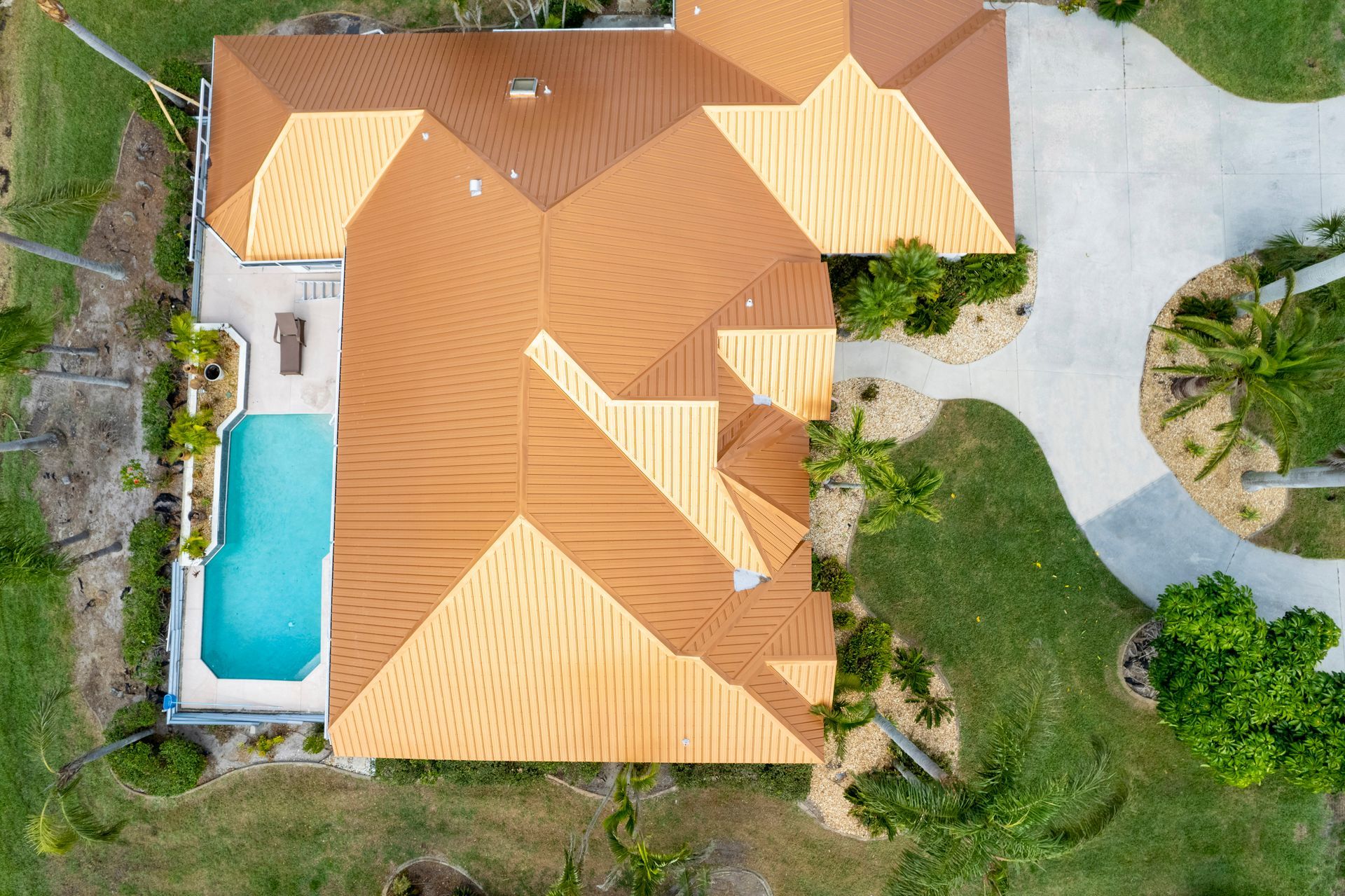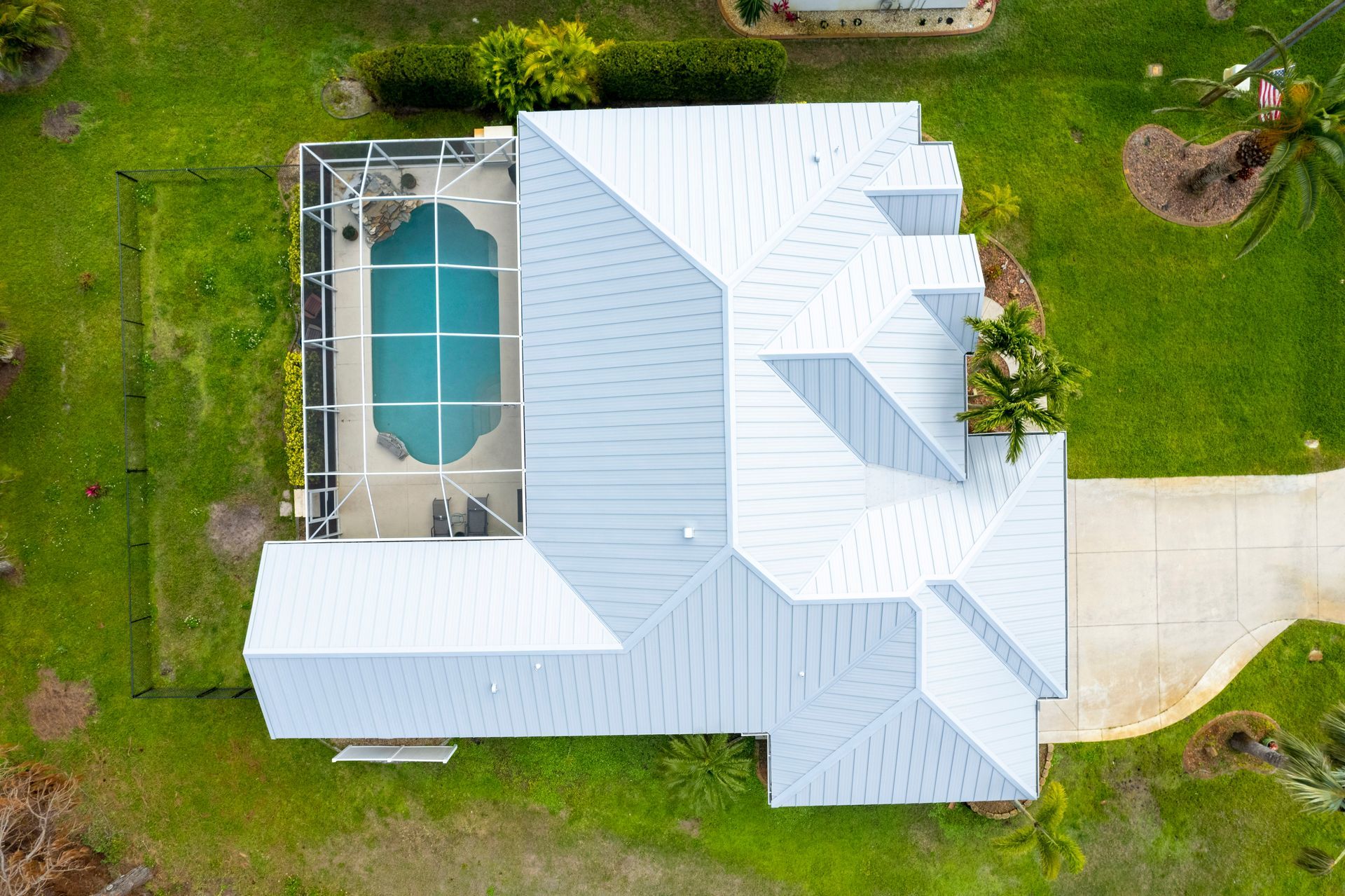Roofing Blog
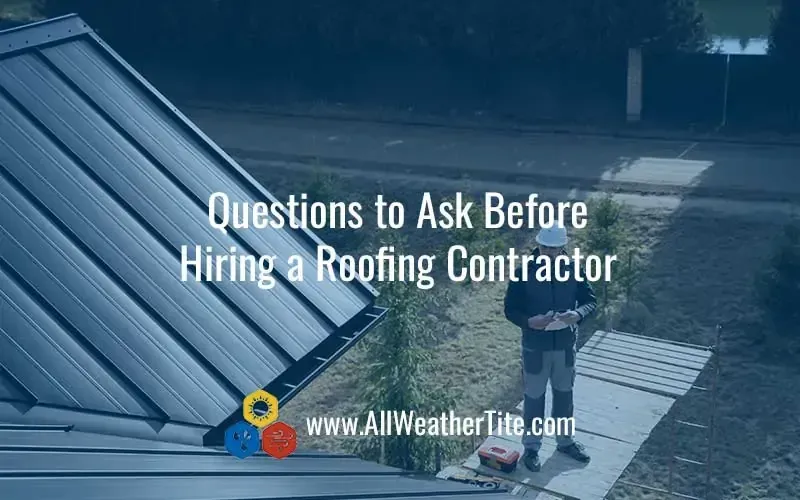
Your home’s roof is the critical component to a safe, warm living environment and an important investment. Replacing it is one of the most expensive home remodeling projects that most homeowners face. Entrusting this important project to a reliable roofing contractor can ensure the safety and longevity of your home. Entrusting its installation or repairs to the right professional can save you from future headaches and costly mistakes. Here are some of the best questions to ask before you hire a roofing contractor. Plus you can download a checklist to have to take notes. These will help you avoid any scams and find the best company to do the job. What is your legal business name? Getting the actual business name of the roofer helps you do a bit of homework on the company. A quality business entity will have filed with their state so they can get the proper insurances and licenses to do business. Search the State of Florida corporate database to see if they are registered locally. Then do a search on that business name to see what comes up in the results. You want to be sure you are dealing with a legitimate business and not someone who will take your deposit and disappear or use low quality materials in place of what you paid for. How long have you been in business? Asking a roofing contractor how many years they have been in business will help you determine what type of experience they have. This question helps gauge their level of expertise, as contractors with more years of experience typically have a broader knowledge base and a better understanding of industry practices. While experience is valuable, it should be balanced with other factors such as qualifications, references, and past project successes. Who owns your business? How long have they owned it? Asking about the ownership of the roofing business and the duration of their ownership helps you gain insights into the company’s stability, expertise, and commitment to quality service. A long-established ownership: Suggests that the business has been successful and able to maintain a positive reputation over time. A well-established roofing company is more likely to have experienced roofers, a proven track record and the expertise to handle various roofing projects effectively. Demonstrates a dedication to customer satisfaction and a desire to build lasting relationships. Such a commitment indicates that the company is more likely to prioritize quality workmanship and provide reliable roofing services. Signifies a level of success and a positive reputation in the industry. Companies with a strong reputation are more likely to prioritize customer satisfaction and deliver exceptional results. It also implies that they have developed relationships with suppliers Do you have proper licensing and certification, insurance and workers comp? It’s important to work only with licensed contractors. A roofing contractor license ensures that they know what they are doing and that your money won’t go to waste because of poor workmanship. You can check on the validity of their license by going to the Florida Department of Business & Professional Regulation website and clicking on Verify A License. Roofing contractors should have workers’ compensation and liability insurance. If they don’t have insurance, the responsibility and liability would fall to you if there is an accident. Workers’ compensation covers you in the case of a contractor injury. If there is no workers’ comp, you may be responsible for medical bills and other costs associated with the injury. Liability insurance protects you from damage caused by the roofers during repair or replacement. If your roof is installed by a contractor without liability insurance, you may not be able to make a claim if there is damage to your roof due to their poor workmanship. Avoid any contractor who doesn’t provide insurance documents, licenses, or warranties. Answers from All Weather Tite: We carry all the proper licensing and use seasoned professionals who are willing to take the time to complete the roofing project the right way. We take pride in hiring experienced tradesmen and providing our customers with the highest quality workmanship. Our work and our workers are fully insured to protect you and your assets. We carry liability and worker’s compensation insurance specifically for roofers. This covers you if there is an unfortunate incident on your property. We will give you the name of our insurance company. Feel free to call to get a certificate of insurance for both liability and workmen’s compensation. Most roof systems require special application expertise to achieve lasting quality. A roofing contractor that carries a certificate with a roofing manufacturer ensures a quality job and the expertise to do it right. All Weather Tite Roofing provides superior workmanship and uses high quality materials from the largest roofing manufacturer in North America, GAF offering the highest warranty in the industry. We have achieved the exclusive status of Master Elite™ Weather Stopper® Roofing Contractor. Only 3% of roofing contractors in the U.S. have achieved Master Elite status. Are you a local contractor? Working with a local roofing contractor makes it easier for you to meet with the roofing contractor. Ask where their home base is and how they can contact you when necessary. A local contractor can be available to help you if you ever have a problem and need emergency storm repairs. Be aware of storm chasers. These are out of state companies that come in after a big storm. They will charge a lot less than local roofing company and disappear once they have your money. Most likely, they don’t care about local codes and may have poor workmanship. A quality local roofing company will know the local roofing codes and the permits required. This helps ensure your roof is correctly installed and in compliance with your state’s requirements. Can you provide a detailed written estimate of the project cost, including labor and materials? A good roofing company should always provide a free, written estimate that outlines the details of the work you are paying for. Requesting a comprehensive breakdown of the project cost, including labor and materials, allows you to assess the financial aspects of the job and make an informed decision. A written estimate helps minimize surprises during the project. You’ll want to know the actual cost of tearing off the old roof, installing the new roof and disposing of debris. The estimate should outline other potential costs, like replacing the underlying plywood decking if they discover damage once the project starts. By understanding the costs upfront, you can anticipate the financial aspects and plan accordingly. Additionally, it provides a reference point to ensure that the final invoice aligns with the initial estimate. Will you provide a written contract that outlines all the project details? It is essential to have a written contract that outlines all the project details when working with a roofing company. Requesting a written contract ensures that both parties are on the same page regarding the scope of work, timelines, materials, and other crucial aspects of the project. It gives you peace of mind. You can proceed with the roofing project knowing that all the details have been documented and agreed upon. It provides a level of security, as both parties are bound by the terms outlined in the contract. A written contract serves as a legally binding document that protects both parties. It establishes the terms and conditions of the project, including payment terms, warranties, and dispute resolution procedures. Having a written contract in place safeguards your interests and provides recourse in case of any disagreements or breaches of agreement. Do you provide a warranty for materials and workmanship? Ask the contractor for information on the manufacturer’s warranties for the roofing materials. You want to know your rights concerning defective products and what circumstances could void the warranty. In addition, ask the roofing contractor if they offer a warranty on their workmanship and for how long. A reputable contractor will stand behind their work and cover issues in the event there are problems. Answers from All Weather Tite We offer a 25 year warranty on workmanship and use shingles from GAF that carry a lifetime warranty. We use top quality materials from industry leaders like GAF, TAMKO, and VELUX to ensure your roof will stand the test of time. Quality and craftsmanship is very important to us. We strive for 100% satisfaction from our customers. Can you help with an insurance claim? Working with a roofing contractor who knows their way around insurance claims is a great way to lessen the burden of making a claim and paying for work that could have been covered by insurance. Dealing with insurance claims can be complex and time-consuming. A knowledgeable roofing contractor can guide you through the process, helping you understand the necessary steps and documentation required for a successful claim. Can you provide references from previous clients? A reputable roofing contractor will have several good references that you can speak with. Get references from recent projects and if possible, go see the workmanship. Some of the references may have provided reviews and uploaded pictures that can help you make you decision. They will also have many reviews available through an internet search. Don’t worry about about a couple of bad reviews if there are many 5 star reviews. Read the reviews and get a good picture of how this contractor handles issues. Answers from All Weather Tite We have many customer testimonials on our website, on Angie’s List and other review sites. We constantly strive to ensure our customers have a great experience with our company. We’ve found that customer reviews are very helpful in keeping our business thriving and are very important to our online visibility. Our past customers love us, and so will you! Will you obtain the necessary permits for the roofing project? Obtaining permits is a crucial step in ensuring that the roofing project complies with local building codes and regulations. It is crucial for the safety and structural integrity of the roof. By acquiring the necessary permits, the roofing company demonstrates their commitment to following the established standards and ensuring a properly constructed roof. But it is also critical that the contractor pull the permit, not the homeowner. If you pull your own permit, you are responsible for any damages or injuries that may occur on your property. By entrusting the roofing company to obtain the permit, you transfer the responsibility to them. This way, you can have peace of mind knowing that the roofing project is being conducted in accordance with local laws and regulations and any issues will be handled by the roofing company. Do you use subcontractors? If so, what are their experience and reputation? When evaluating a roofing contractor for your project, it’s crucial to ask questions about their use of roofing subcontractors and gather information about the subcontractor’s experience and reputation. Most roofing companies do use subcontractors. It’s good to understand the structure of their team, their experience with the type of roofing materials you are using and how they will complete the work. Roofing contractors hire subcontractors to perform specific tasks on their behalf. However, they should still maintain overall responsibility for the project and ensure that the subcontractors meet the necessary standards. Do you offer onsite inspections and estimates? If a contractor tries to offer you an estimate over the phone without also setting up an appointment to view the roof firsthand, you may want to consider another contractor. You can only assess the size, shape and condition of the roof by an onsite inspection. The less than reputable contractors will give you a low estimate but continue to add on costs and fees. A reputable contractor visits the property to understand the scope of the project. Then they will provide you with a realistic quote. Answers from All Weather Tite You can request an estimate using our online form and will promptly come out to the home to take a look at the potential job. Once we have inspected the roof, we will give you a clear and concise estimate covering all the costs associated with doing the job right the first time. Do you clean up the site and remove all the old roofing materials upon leaving? The quote should always include cleaning up your yard and disposing the old roofing material after the work is done. Always ask a potential roofing contractor if they include this item. Don’t get stuck with a pile of debris in your yard that will cost you to have hauled away. Answers from All Weather Tite We promptly clean up all materials. You’ll never know we were there! Final Thoughts Looking for a trustworthy and reliable roofing contractor can be stressful, especially when it is an emergency. As a homeowner, it is good to have a trusted roofing contractor that you can call on to handle your various roofing issues whenever they arise. Hiring a roofing contractor is your best option, but you must first get answers to these questions before dealing with them. And don’t forget to download our checklist to take notes. Let us know if we can help.
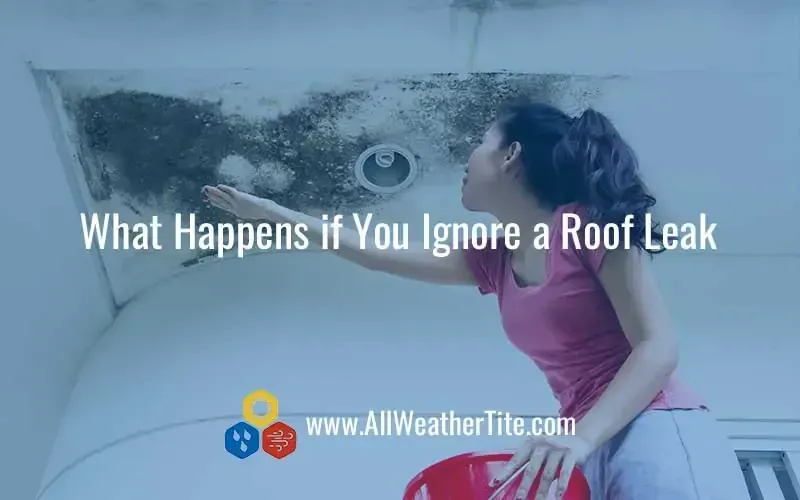
Many view a roof leak as a mere annoyance, easily dismissed in hopes it will go away on its own. However, if you neglect it for too long, it can lead to costly consequences. The better course of action is to get it fixed as soon as possible. Waiting to repair the leak until it turns into a bigger problem will rarely save you money because the longer you wait, the more damage is done. Here are things that can happen if you decide to go the other route and simply ignore a leak in your roof. Structural damage Water from a leaky roof can seep into the structure of your home and pose a threat to the integrity of your home. This can deteriorate structural components such as wood, rafters and supports, jeopardizing the safety and stability of your property. Ignoring this issue can result in costly repairs or require a complete roof replacement. Mold and mildew It’s easy to downplay a minor leak in your roof, brushing off a few water stains as inconsequential. However, a water leak extends beyond mere dampness. It creates a breeding ground for mold and mildew, lurking within walls, insulation, and ceilings when left unchecked. Neglecting these leaks fosters ideal conditions for mold proliferation, leading to extensive cleanup efforts and inflated repair costs. Moreover, mold poses health hazards, particularly for those with allergies or asthma. Even without allergies, exposure to mold can provoke irritation in the eyes, skin, nose, throat, and lungs, contributing to a range of health issues for you, your loved ones, and even your pets. Interior damage Roof leaks can cause damage to your home’s interior. Water stains on ceilings and walls, damaged paint and wallpaper, and ruined personal belongings are just the beginning. Consequently, the longer any water sits and hits those areas, the more damage it will do and the more expensive the repairs will become. Decreased property value Neglected roof leaks can significantly reduce the value of your home. Potential buyers are may be deterred by visible water damage and the potential for costly repairs. A well-maintained roof is essential for preserving the value of your home. Get expert advice Whether your roof is made of metal, asphalt or tile, the consequences of neglecting a leaking roof go beyond a minor inconvenience. Structural damage, mold growth, decreased property value, and safety hazards are just a few of the issues that can result if you ignore a roof leak. By addressing leaks promptly and investing in proper maintenance, you can protect your home, your health, and your investment for years to come. Therefore, if you suspect you may have a leak in your roof, take action promptly and contact an expert today.
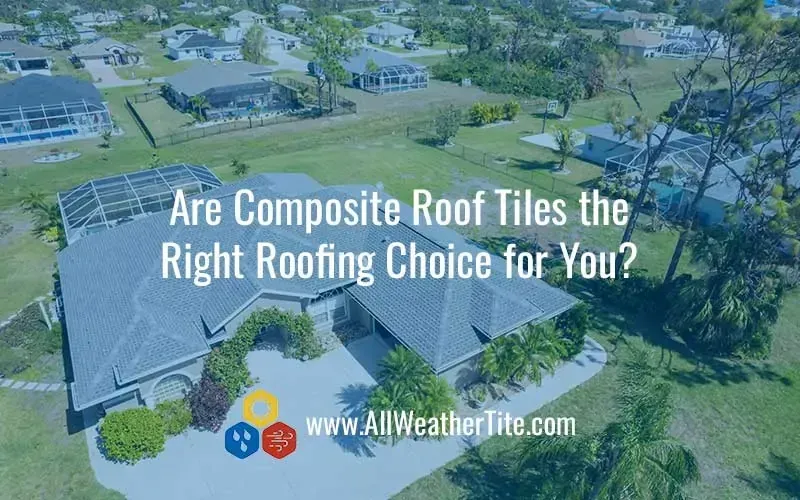
Choosing the material for your roof replacement project is an important decision. Unlike in the past, there are more choices, and therefore, more decisions you need to make. If you’re in the market for new shingles, you have a choice of asphalt, composite or metal as options. Relatively new to the roofing industry, composite roof tiles are gaining popularity. What are composite roof tiles? Residential roofing known as composite or synthetic roof tiles are gaining popularity due to their robustness and lasting durability. They can be a blend of a number of materials including fiberglass, slate, laminate, tar paper and wood fibers. These shingles incorporate polymers for strength and to combat the impact of ultraviolet radiation. Manufacturers use molds of slate tiles to craft synthetic shingles that mimic the appearance of a slate or cedar shake roof. The outcome is a resilient product capable of withstanding high winds, hail and intense sunlight. Benefits of using composite roof tiles Selection. Composite roof tiles come in a variety of styles and colors, mimicking the appearance of a slate or cedar shake roof. This highly versatile choice gives you the ability to increase the curb appeal of your home with a higher-end look at a more reasonable price. Durability. Composite tiles boast a long lifespan and have low maintenance requirements. They are resistant to rot, insects, and mildew, don’t have problems with moisture and do not crack, split, peel or warp. Additionally, these tiles are resistant to fire hazards. You’ll have peace of mind knowing your property is safe. And even after years of dealing with intense Florida weather, your roof will have little wear and tear! Cost effective (compared to real slate). If you choose composite slate over real slate, you’ll find it’s a cost-saving decision. That’s because composite slate is cheaper than real slate. And the added benefit is that it provides the same aesthetic appeal. Eco-friendly. Composite roof tiles are made out of recycled materials. Most are made from a mix of plastics, sawdust, rubber and fiberglass. Others are fashioned with recycled tires or hoses. And an added benefit is that some types of composite shingles can be recycled once their useful life is over. Remaining scraps and materials from your roof replacement can also be recycled. Longevity. Composites last 30 to 50 years before needing replacement. Disadvantages of selecting composite roofing Relatively new roofing material. It’s no secret that composite roof tiles are newer to the roofing industry. As a result, there are some unknowns. But to mitigate this situation, manufacturers will usually offer warranties. Upfront expenditure. The upfront cost will likely be higher when installing composite verses asphalt. However, as noted in the previous section, this situation will likely be mitigated due to its durability and the shingle’s long lifespan. So, it’s important to keep that in mind. Color fading. Over time, exposure to sunlight can cause the colors of the shingles to fade. Although many manufacturers are taking steps to minimize this, it could affect the visual appeal of the roof. Not suitable for steep roofs. In certain situations, like steep roofs, this option may not be the best choice due to their lightweight nature. Although asphalt shingles are currently the most popular choice for shingles in the United States, the popularity of composite shingles is rapidly growing. And even though asphalt can be a more economical choice, composite roofing carries a longer warranty and can mimic the look of many different roofing materials. Now it’s decision time! You’ve read about the advantages and disadvantages to using composite roof tiles. Before making your decision, it’s important to think about the pros and cons based on your specific needs. And if you require additional information, contact an expert today!!
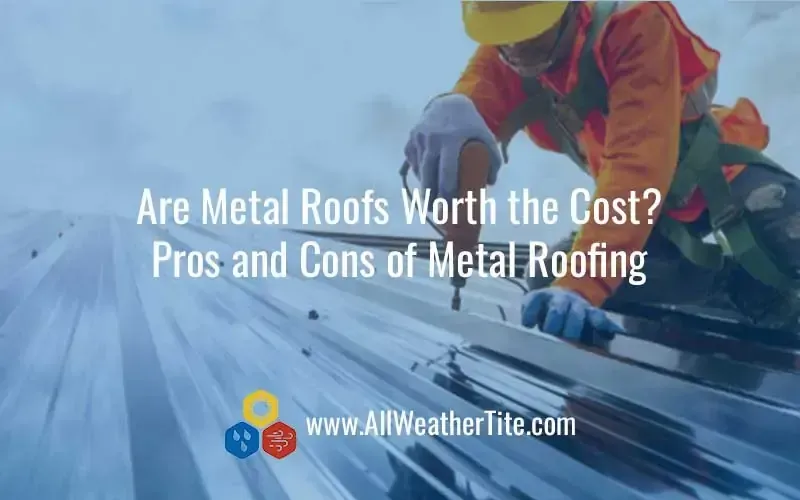
For decades, according to Bob Vila.com, metal roofs meant corrugated panels, which looked like they belonged on sheds, barns or commercial-looking standing-seam applications. Today, the metal roofing products available can match every architectural style. Metal roofs for homes come in popular styles such as shingle, shake, slate and tile styles. These new choices have reinvigorated the metal roofing industry, becoming the second-most popular choice in about 11% of the roofing material market. But many Florida homeowners ask if the metal roofs are worth the extra cost. If you are looking to replace the roof on your Florida home, here are pros and cons of metal roofing to consider. Pros of Metal Roofs Durability Thanks to advances in rust-proofing technology, metal roofs do not deteriorate when exposed to weather and sunlight over time like asphalt shingle roofs do. In fact, a typical asphalt shingle roof would need to be replaced three times during the lifespan of one metal roof. Although some asphalt shingle manufacturers, such as GAF, provide 50-year and lifetime warranties for their premium roofing products, these cost almost as much as metal. Nearly all metal roof manufacturers provide lifetime warranties for their materials. Appearance Metal roofs now come in wide range of colors, styles, finishes and textures to match your home exterior. With virtually any color available, metal roofing can be shaped to resemble any roof material, from asphalt shingles to cedar shakes or even tile. Sustainability Since traditional asphalt shingles are a petroleum product, they increase dependency on fossil fuels, whereas metal roofing does not. New metal roofing materials are usually manufactured with 30 to up to 95 percent recycled metal. The metal is either steel, aluminum or copper. Environmentally Friendly When a metal roof reaches the end of its lifespan, it can be completely recycled again. By contrast, traditional asphalt shingles must be replaced every 15 to 20 years, which means that nearly 20 billion pounds of old asphalt shingles are sent to U.S. landfills every year, according to the Environmental Protection Agency. For homeowners looking for more ways to go green, metal roofs provide an excellent platform for photovoltaic systems, solar panels, or rainwater harvesting for reuse/irrigation. Energy Efficiency Metal roofs can save homes up to 40% in air conditioning costs. They also provide excellent insulation in colder weather. A basic, unpainted metal roof will reflect more solar radiation than an asphalt roof, which typically absorbs and holds heat. Pre-painted or granular-coated metal roofing materials keep your home cool by not only reflecting solar energy, but also emitting solar energy instead of allowing it to radiate heat into the attic. Low Maintenance Metal roofs naturally repel moss and algae, and require very little upkeep. To keep a metal roof in tip-top shape, remove debris and inspect it annually for minor maintenance items such as cleaning and/or paint touch-up. Resale Value Homes with new metal roofs gain on average, up to 6% more in resale value over homes with a new asphalt shingle roof, according to the Metal Roofing Alliance. Many insurance companies give discounts of up to 35 percent to homes with metal roofs. This is because when properly installed, they are virtually impervious to wind, hail, and fire, even hurricanes. Cons of Metal Roofs May cost more than asphalt Metal roofs can cost on average $500 to $1800 per square (100 square feet) compared to $120 to $400 per square for an asphalt shingle roof. This means that an average metal roof will cost about three times the average cost of an average asphalt roof. For an average 2,500 square-foot home with a 14-square roof, the average difference in cost would be over $12,000. Although most homeowners will recoup the cost difference over time by not having to replace the roof for 50 years or more. The cost of the metal roof is worth it if you also consider the savings from: Reduced energy use Insurance discounts Reduced maintenance costs Increased home resale value But the up-front investment for a metal roof can be a significant deterrent. Can easily dent Metal roofs can dent from falling branches or very large hailstones. However, having a distressed or textured metal roof will hide most dents from hail or branches. Keeping trees pruned back from the roof also reduces the chance of a falling limb causing damage. Can be noisy If not properly insulated, metal roofs can be noisy. But asphalt roofs can be noisy too if the attic is not properly insulated. With adequate attic space and proper insulation, a metal roof is generally no louder than other roof types. Over time, metal roofs have improved in style, functionality and durability, gaining popularity due to its long lifespan and resistance to high winds and leaks. Plus many myths about metal roofs have been debunked. With the potentially harsh weather of Southwest Florida, metal roofs are more durable. If you are asking if installing a metal roof on your home is worth the cost, contact an experienced roofing contractor to see if it is right for you.
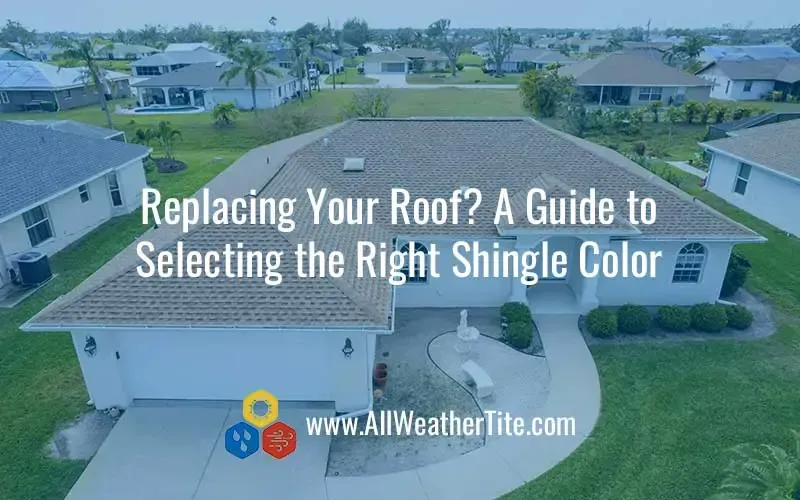
Your roof is one of the most vital parts of your home’s exterior. In fact, its style and color is one of the first things people notice when they pass by your home. So, when it’s time to replace your roof, don’t neglect one of the most important decisions: choosing the right shingle color. Why Shingle Colors are an Important Consideration The color you select affects aesthetics and functionality. It can impact your home’s curb appeal, energy efficiency, and your roof’s longevity. So, it’s important to consider things like your home’s architectural style, the climate in your area, and your personal preferences. But, the roofing industry offers a huge variety of shingle products, color variations, and upgrade options. The choices can make a homeowner feel overwhelmed. Read on to discover key factors to think about when choosing the best shingle color for your new roof. Architectural style You should consider your home’s architectural style when selecting a shingle color. Traditional homes look better with classic colors like earthy tones or shades of brown. On the other hand, you can use bold color choices to complement modern designs. Your personal preference should play a key role in your decision, however. It’s important to select a shingle color you like and will work well with your home’s exterior elements. So plan your exterior color scheme appropriately. Coordinate your colors with your siding and windows. Choosing a bold shingle color for your roof might not always be a good choice. Your roof is the biggest surface of your home. A dark gray or black roofing shingle will look great with a gray or blue house. A brown, cream, or tan colored house might match better with brown roof shingles or a mixture of cream and brown. Energy efficiency Energy-efficient roofing can save you money on heating and cooling. Light-colored shingles reflect heat and help reduce your cooling costs, which makes them a better choice for Florida homes. White, light greys and beiges can all help reflect the sun’s rays. This reduces the amount of heat the roof absorbs. The less heat, the better your HVAC system can keep your property comfortable during the hottest parts of the year. While color does play a role in helping your roof be more energy-efficient, your attic ventilation is more important. A properly ventilated attic, including an attic fan, helps move air around in your crawlspace, preventing your roof from becoming super-heated. Without ventilation, roof temperatures can reach over 150°. When your roof gets this hot, the materials can begin to degrade or disintegrate. Your roof is more susceptible to leaks, damage, and premature replacement when this happens. Durability It’s important to understand some shingle colors are more durable than others! For example, some colors fade or show wear more quickly. However, if you are installing high-quality shingles and working with a reputable roofer, you do not need to worry about your darker shingles being damaged by the heat. Modern roofs are made with innovative materials engineered to withstand high temperatures and UV rays. Look for shingles with UV protection to help maintain their color over time. Regardless of the color of your roof, you should schedule annual roof maintenance. This becomes even more important the older your roof is. During your maintenance visit, your roofing contractor will let you know the current condition of your roof and whether the roof’s color is contributing to any repair issues they find. Resale value and neighborhood considerations If you plan to sell your home in the future, keep in mind your choice of shingle color can affect its resale value. It’s best you stay away from unusual color combinations that may go out of style quickly. Neutral colors tend to be more appealing to potential buyers. If you live in a community with a homeowner’s association, there may be requirements for what you can use on your roof. Check your HOA documents to make sure you can select the product you want for your roof. Samples Before making your final decision, get some shingle samples. Your roof color needs to coordinate with all the other exterior colors so they don’t clash. The color also needs to align with the style of the home and your exterior elements. Once you’ve selected the roofing company you will be using, request large samples of all the shingle colors you are interested in. Check how the samples look at different times during the day. You can also use online tools to help you visualize how different colors will look on your roof. This will help you make a more informed decision. Choosing the right shingle color is a crucial step in the roof replacement process. Make sure to consult with roofing professionals for expert advice and installation to ensure a successful roofing project.

Stone-coated metal roofing is a popular roofing option due to its durability and aesthetic appeal. It combines the industrial strength of steel with the elegance of traditional roofing materials like shingles, shakes, and tiles. What is Stone-Coated Metal Roofing? Stone-coated metal roofing is a metal shingle coated in paint and stone granules. This makes the roofing resistant to rust, corrosion, and fading. They have the classic look of traditional shingles, but offer low maintenance and longevity of a metal roof. This roofing material offers a variety of styles and colors. They look similar to traditional roofing materials like shingles, roof shakes and roofing tiles. This makes this roofing option versatile, offering a perfect match for your tastes and home style. Homeowners are able to achieve a desired look while still benefiting from the durability of metal. Other advantages include: Highly durable and can last for 50 years or more. They are resistant to cracking, warping, and fading, making them an excellent long-term investment. Can withstand a wide range of weather conditions, including heavy rain, hail, snow, and high winds. They are also fire-resistant, adding an extra layer of protection to your home. Reflect the sun’s rays, helping to keep your home cooler in hot weather. This can lead to energy savings by reducing the need for air conditioning. Are environmentally friendly. When this roof needs replacing, the old shingles can be recycled. Minimal maintenance over their lifespan. They are not prone to moss or algae growth, and they do not rot or warp. Provide long warranties, often ranging from 30 to 50 years. This provides peace of mind to homeowners. Cons of Stone-Coated Metal Roofing Although there are a lot of benefits of putting a roof made of stone-coated metal on your home, especially in Florida, there are some disadvantages for some homeowners. Initially, stone-coated metal roofing can be more expensive than other roofing materials, such as asphalt shingles. However, the long-term durability and energy savings can offset this initial cost. While durable, the stone coating can be susceptible to scratching, especially during severe weather events or when walked on. However, this typically doesn’t affect the roof’s performance. Installing stone-coated metal roofing can be more complex than installing traditional roofing materials. It’s important to hire experienced professionals to ensure proper installation. During heavy rain or hail, they can be noisier than some other roofing materials. However, underlayment and insulation can help absorb the sound and reduce noise. There are limited repair options for a stone-coated metal roof. If you do get damage, it can be challenging to repair individual panels or sections. This may necessitate a more extensive replacement. Should You Consider this Roofing Option? Stone-coated metal roofing offers many advantages in terms of durability, longevity, and aesthetics, which is important when facing our challenging Florida weather. But it may come with a higher upfront cost and installation complexity. Homeowners should carefully weigh these factors against their specific needs and budget when considering this roofing option.
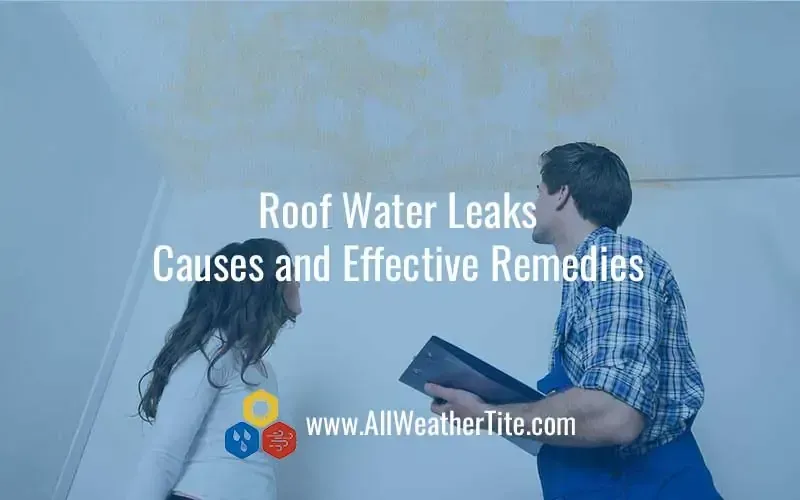
The primary job of your roof is to keep the outside out and the inside in. And for most homeowners, the most important job of your roof is to keep the rain out. When you see the tell-tale signs of water leaks coming into your home, you start to feel dread and panic knowing that the cause could be a major roof project to fix. If you have a roof leak, act quickly and contact a roofing expert. They can often provide a free estimate, which includes the source of the leak and cost to repair it. While waiting, try and figure out where the water is coming from. Trace the problem to its source Somehow water has made its way into your ceiling, most likely from roof or pipe leaks. If the damage is in your basement, it could be a faulty drain or pipe from the upstairs plumbing. Occasionally water damage is not connected to a leak (like condensation). Be careful to double check all alternatives before deciding there isn’t a leak. Inspect your attic for signs of mold or dampness. Water leaks can be hard to trace because it can run far from the original entry point before it begins to drip and show itself in the form of damage. However, it’s important to deal with the cause of the problem. If you don’t address the actual leak, repairing and repainting the stains will only cover up the effects of the leak until the next downpour. False Alarms of Roof Leaks When you spot water damage on your ceiling, hear the drip-drip-drip of water in your drywall, or find strange pools of water in rooms where there shouldn’t be any, most people’s first thought is: leaking roof. However, your home is a complicated structure, so unless you can immediately spot the problem, it’s worth looking at: Improper Ventilation of Attic Spaces – Without proper ventilation of your attic, moisture in your home rises to the attic space. This moisture then turns to liquid and can drip back into your home. Leaking AC or HVAC System – Especially during summer, it’s worth checking your cooling systems for leakage. Leaking Pipes – While many homeowners don’t realize it, ceilings and floors also contain water piping. This situation is further complicated by water traveling horizontally before leaking to down below. All of these problems are not connected to the roof. However, in the case of improper ventilation, most roofing companies can help install attic ventilation. Most Likely Sources of Roof Leaks Here are some of the most common sources of roof water leaks that can happen in your home. Some are caused by weather, wear and tear, improper installation of the roof or shoddy roof repairs. Age of the roof Over time, roofing materials can deteriorate due to exposure to the elements, causing cracks, gaps, and other forms of damage that allow water to seep through. Improper installation There are many parts to a roofing system. Improper installation of the shingles, valley flashing, utility collars, chimney flashing, and skylight flashing can cause major leaks. Poor workmanship may have left gaps or seams that can let water in. In addition, inadequate flashing can allow water to seep in around chimneys, skylights, or other protrusions on the roof. Damaged shingles or flashing Cracking and missing shingles allow water free reign into your home. Over time shingles can deteriorate and warp, causing the same problems. Bad weather or through normal wear and tear can damage flashing. Some flashing is secured with seals or caulking, which can deteriorate over time. Wind driven rain High winds can drive rain water almost horizontally into your home, including through outside ventilation. Standing water Water that ponds on your roof spells trouble: constant contact with water will cause shingles to deteriorate and underneath structure to rot. Debris buildup Gutters that are clogged with debris can prevent water from flowing freely, causing it to back up and overflow onto the roof. Other debris that accumulates on the roof such as leaves, sticks and branches can trap moisture on the roof, having a similar effect to standing water. Venting boot failure Roof vents are used to expel excess moisture from the inside of the house. Roof vents are sealed by placing flashing around the opening and slipping a tight, rubber boot over the area where the pipe peeks out of the roof. Over time, the flashing and rubber boot can deteriorate and cause a leak. Identify and repair the source of the leak If you suspect the leak is caused by the roof and not something else, it is important to identify the source of the leak and repair it as soon as possible. Here are some likely locations to check: Boots (these are rubber pieces sealing electric service areas, plumbing vent pipes, air vents, and exhaust fan flashing) Ridge cap (the very top of your roof) Gaskets (around pipes) Flashing (around chimney) Gutters and downspouts Shingles (look for obvious tears, erosion or other signs of damage) Dormer valleys These are places which often allow water to seep in. Once you find the source of the leak, repair or replace the area of trouble. Be careful to complete the process thoroughly as a poor job will just invite additional leaks (and headaches!). Consider professional assistance if you are not comfortable performing repairs or inspections on your own. Hire a professional roofing contractor to identify and repair any leaks. Easy ways to repair interior damage Depending on the severity of the damage, you may want to hire an experienced professional. However, there are some repairs that are more DIY. Here are some generic instructions to repair small interior stains and paint bubbling. First, scrap off the bubbling paint then smooth the surface by using a piece of soft sandpaper. Paint on a coat of oil-based primer and let dry for a few hours. Next, apply a thin layer of Spackle with a metal knife, let it dry (make sure it dries completely). Sand the area thoroughly. Spackle again. Once it is smooth, apply primer, and then finally, repaint. If during this process you find there is a large mushy area or holes in the drywall, this may be out of your expertise. Maintenance costs less Roof water leaks can cause significant damage to your home or business if left unchecked. Identifying the cause of the leak and fixing it as soon as possible can help prevent further damage and extend the life of your roof. Consider a roof maintenance plan. Regularly cleaning your gutters and downspouts can prevent clogs and keep water flowing freely away from the roof. Regular inspections can help identify potential problems before they become major issues. In addition, routine maintenance such as cleaning gutters and replacing damaged shingles can help extend the life of your roof. Roof repair and replacement is expensive. Regular maintenance is something you can budget and plan for. If you are having trouble with a leaky roof or you can’t identify the source of the problem, contact us at All Weather Tite, expert roofers servicing Southwest Florida, with the expertise to locate and repair roof leaks, as well as partial or full roof replacement. Our highly trained professionals will be happy to discuss any issues or set up a free consultation.
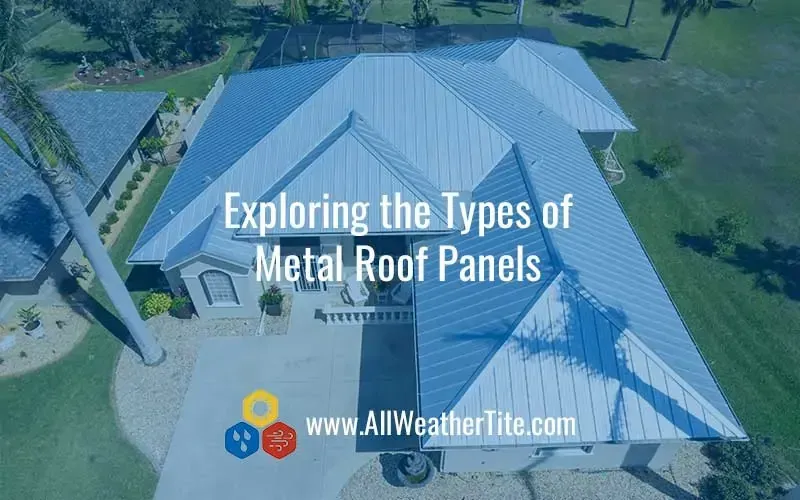
Metal roofing has gained significant popularity over the years due to its durability, longevity and energy efficiency. Among the various elements that make metal roofs appealing are the type and style of metal roof panels. With an array of options available in the market, homeowners and builders can choose from different types of metal roof panels to match their specific needs and aesthetic preferences. Explore some of the most common types and stylish designs of metal roof panels, highlighting their unique features and benefits. Metal Roof Materials Residential metal roofing is generally made of steel, aluminum, copper, and zinc. Metal roof materials provide benefits such as durability, longevity, low maintenance, fire resistance, and energy efficiency. They are available in a variety of styles, colors, and profiles, allowing homeowners to achieve their desired look and match the architectural style of their home. Additionally, metal roof materials are often recyclable, making them an environmentally friendly choice. Aluminum Roofing Aluminum is a lightweight and highly durable metal, making it an excellent choice for roofing applications. Its natural resistance to corrosion and rust ensures that an aluminum roof can withstand the harshest weather conditions. Aluminum: Is non-combustible, providing enhanced fire resistance for added safety. Offers exceptional longevity, often lasting for 50 years or more with minimal maintenance. Reduces heat absorption due to its reflective surface, leading to energy efficiency and potential cost savings on cooling expenses. Needs to be painted but comes in a wide range of colors, allowing homeowners and builders to achieve their desired aesthetic appeal. More expensive than steel roof panels Is warrantied against salt water (within 1000 yards of salt water) Only comes in standing seam Overall, aluminum roofing offers a reliable, long-lasting, and aesthetically pleasing solution for both residential and commercial projects. Steel Roofing Steel roofing is a robust and reliable option that has gained widespread popularity in the roofing industry. It is a popular choice due to its strength, affordability, and availability in various profiles and finishes. Its exceptional strength and durability makes it highly resistant to extreme weather conditions such as high winds and heavy rain and can withstand impact from hail or falling debris. Steel roofs: Fire-resistant, providing an added layer of safety to buildings. With proper installation and maintenance, steel roofs can have a lifespan of 50 years or more. Strong and can resist warping, chipping or cracking. It can survive winds as strong as 140 – 160 miles per hour depending on the installation method, as well as impacts from falling objects. Recyclable, making them an environmentally friendly choice. Least expensive but still the most efficient roofing material, offering about the same qualities as the others. Are not warrantied within a 1000 yards of salt water due to its potential to rust Finished in a a coat consist of zinc, aluminum, and silicone called Galvalume Steel roofing is available in a variety of styles, including standing seam panels and corrugated sheets. This allows for versatile design options to suit different architectural styles. Steel roofing is actually the most popular material that people use. Copper Roofing Copper is renowned for its timeless beauty, durability, and natural patina that develops over time. It is often chosen for its aesthetic appeal and longevity. This gives them a unique and elegant appearance that adds character to any structure. One of the most notable qualities of copper is its natural resistance to corrosion. This makes it an excellent choice for areas with high humidity or coastal environments. Copper roofs: Have an impressive lifespan, often lasting for well over a century with minimal maintenance. Are also highly resistant to fire, pests, and extreme weather conditions. Has excellent thermal conductivity, which helps regulate temperature and can contribute to energy efficiency. Cost more than other materials, but its longevity and aesthetic appeal make it a worthwhile investment for those seeking a luxurious and long-lasting roofing solution. Are rarely used near salt water but are warrantied if you wish to use copper Just like aluminum roofing, copper roofing can last up to or well over 50 years with proper maintenance. It’s one of the best materials you can use for your roofing, providing a unique look for your home. Zinc Roofing Zinc roofing material has gained popularity in recent years due to its exceptional durability, aesthetic appeal, and environmental sustainability. These roofs offer a distinct and elegant appearance with their unique matte finish that evolves over time, developing a beautiful patina. This natural patina not only enhances the visual appeal but also provides a protective layer that helps the roof resist corrosion and weathering. Zinc is a highly durable material, capable of withstanding extreme weather conditions, including heavy rain and wind. It is also resistant to mold, mildew and moss growth. Another notable advantage of zinc roofing is its longevity, with a lifespan of 50 to 100 years or more, depending on the local climate and maintenance. Additionally, zinc is a recyclable material, making it an environmentally friendly choice. Its low energy consumption during production and ability to be recycled at the end of its life contribute to its sustainability. While zinc roofing may have a higher upfront cost compared to some other roofing materials, its long-term durability and low maintenance requirements make it a cost-effective investment for homeowners looking for a high-quality, visually appealing, and sustainable roofing solution. Styles of Roof Panels Standing Seam Panels

Homeowners often overlook two key roofing components but play a crucial role in protecting your home. Soffit and fascia work in tandem to create an unbroken appearance that provides a shield for both your roof and the exterior of your home. However, the overhang of a roof is often the first area to deteriorate due to decay, paint peeling, and other climate-induced issues. What are soffits? Soffits are the underside of the roof overhang that extends from the eaves to the exterior walls of the house. They are typically made from wood, aluminum, vinyl, or other materials that can withstand exposure to the elements. Soffits play a crucial role in ventilation. They allow air to circulate in the attic space and prevent moisture buildup that can lead to mold and rot. There are two main types of soffits: vented and non-vented. Vented soffits have small perforations that allow air to flow through, while non-vented soffits do not have any perforations. Vented soffits are more common and recommended as they promote ventilation and help prevent moisture buildup. What are fascia? Fascia board are the vertical board that runs along the edge of the roofline. Its job is to support the bottom row of roof tiles or shingles. They are typically made from wood, aluminum, or vinyl and are installed along the entire length of the roofline. Fascia boards also help protect the interior of the house by preventing water and moisture from entering the roof cavity. Fascia boards also play a crucial role in creating a seamless look along the roofline. You can paint or finish them to match the color of the roof tiles or shingles. They are available in a variety of styles to complement different architectural styles. Why are soffits and fascia important? Soffits and fascia play a crucial role in protecting your roof and your home’s exterior. Here are some of the key benefits of these components: Ventilation – Soffits allow air to circulate in the attic space. This prevents moisture buildup and reducing the risk of mold and rot. Vented soffits are particularly effective in promoting ventilation. Moisture protection – Fascia protect the roof cavity from water and moisture, preventing damage to the interior of the house. Aesthetics – Soffits and fascia create a seamless look along the roofline, enhancing the overall appearance of your home. Energy efficiency – Properly installed and ventilated soffits and fascia can help reduce energy costs by improving air circulation and preventing heat buildup in the attic space. Durability – High-quality soffits and fascia are designed to withstand exposure to the elements. They can last for many years, reducing the need for repairs or replacement. To ensure that your soffits and fascia continue to protect your home effectively, regular maintenance is essential. Tips to help you maintain your soffit and fascia Clean them regularly Dirt, debris and mold can accumulate on soffits and fascia over time, so it’s important to clean them regularly using a soft-bristled brush and a mild detergent. Avoid using abrasive cleaners or pressure washers, as they can damage the material. Check for damage Inspect your soffits and fascia regularly for signs of damage, such as cracks, warping, or rot. If you notice any damage, have it repaired or replaced as soon as possible to prevent further damage to your roof and home. Trim nearby trees Overhanging tree branches can scratch and damage soffits and fascia. Therefore, it’s important to trim any nearby trees regularly. This will not only prevent damage but also ensure proper ventilation by allowing air to flow freely. Ensure proper ventilation Make sure that you ventilate your soffits and fascia properly to prevent moisture buildup and reduce the risk of mold and rot. Keep the vent openings clear of debris and ensure that they are not blocked by insulation. Repaint or refinish as necessary Over time, the paint or finish on your soffits and fascia may start to peel or fade. Repaint or refinish them as necessary to protect the material and maintain their appearance. Hire a professional for repairs If you notice any significant damage or if you’re unsure about how to maintain your soffits and fascia, it’s best to hire a professional. They can assess the condition of your soffits and fascia and recommend the necessary repairs or replacements. By following these tips, you can ensure that your soffits and fascia continue to protect your home effectively and enhance its appearance for years to come. Regular maintenance can also help prevent costly repairs or replacements down the line, saving you time and money in the long run. Contact All Weather Tite for professional guidance on how to maintain or install new fascia and soffits.
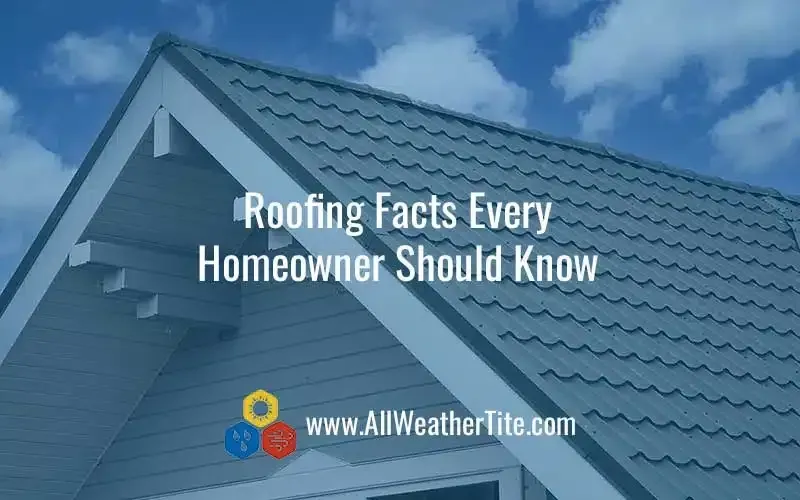
Your roof is a very important part of your home. It protects the structure and those that live in it from the crazy weather elements. There are also many interesting roofing facts that might help you understand the importance of keeping your roof well-maintained. Total roof replacement is better than roofing over the old Some people think you can save money putting a new roof over the old. In the short-term, that may be true. But you are just covering up problems that will rear their ugly head sooner than later. Regardless of which roofing materials you choose, you should always let the roofer tear off the old roof and roofing materials and repairs any damage prior to installing your new roof. The weakest spot on the roof is near the flashing A roof flashing is a thin metal material that roofing contractors install in buildings to redirect water away from roof valleys and chimneys. If you have damaged shingles underneath the roof flashing, water can still find its way through the tiny gaps and get inside your home. Damaged shingles underneath the flashing can cause dry rot that can deteriorate the roof and cause more issues. Roof ventilation is a delicate balance A well-ventilated attic is important for the health of your home and your roof. With ventilation, however, having too much can lead to problems. There are specific guidelines regarding the proper ventilation for your specific roof. Proper roof ventilation is not only better for the maintenance of your home, but most roofing material manufacturers require adequate ventilation to maintain their warranties. You get what you pay for Many homeowners want to get the best price for their roof. Since it’s normally out of the way, why put a lot of money into something you don’t get to use or enjoy? But cheaper doesn’t mean better, not in the case of the roofing materials or especially for the contractor’s services. Generally, when it comes to something as important as your roof, you want to invest in quality. Don’t put your home at risk with subquality materials and labor. Your home is one of your biggest investments. Be sure to research your contractors before selecting one to do the job. Your gutters are part of your roofing system Gutters may not seem like a deal, but they are an integral part of the system that protects your roof and your home. When it rains, gutters are responsible for moving water from your roof away from your home safely. Gutters that are jammed or clogged stop them from doing their job. The water instead simply pools up on your roof, dealing severe damage to the materials and potentially even causing nasty leaks. It’s extremely important that you keep those gutters clean, whatever it may take. A new roof needs regular maintenance A new roof removes the concerns that something could happen that would cause major damage. But just because the roof is new, doesn’t mean you shouldn’t provide proper care and maintenance to keep it that way. You shouldn’t have any major issues with a new roof, like leaks or cracking tiles if you hired a reputable contractor. Regular inspections and maintenance can help prolong the life of a roof and prevent leaks. The roofer that put installed your roof should have a workmanship warranty. Check to see if they also provide regular roof inspection every couple of years to keep your roof in perfect shape. Just remember, a well-maintained roof performs better, looks better and lasts longer. Never repair your roof yourself Unless you have a background in construction and professional roofing, do not ever try to fix significant issues on your roof on your own. Repairing a roof properly takes years of experience and knowledge to do the job right. Your roof is what protects your investments both inside and outside of your home. Learning to repair what you think is the problem yourself could not only fail, but also put your warranty at risk. A warranty on a roofing system typically covers defects in materials and workmanship but not damage caused mistakes a non-licensed person causes or natural events like storms. Always consult a qualified roofing professional when it comes to roof repairs and replacements. A roofing contractor should be licensed and insured to protect homeowners from liability in case of accidents or damage. Doing it all by yourself can cause you a lot more than what you think you saved in the long run.

Your roof’s primary job is to protect your home. However, your roof also plays a role in the efficiency of your HVAC system. In Florida where our temperatures are high for most of the year, it is also important that your roof is energy efficient so the heat doesn’t transfer into your home and make the HVAC system work harder. So as a homeowner, how do you know whether your roof is energy efficient? Unfortunately, 90% of roofs in the United States have poor design and use dark, non-reflective materials that absorb rather than reflect heat. Rooftop temperatures can exceed the outside air temperature. And this heat can transfer into your home and make your HVAC work harder. The benefits of energy efficient roof Energy-efficient or “cool” roofs benefit their occupants as well as the environment. Some of the benefits of cool roofs, according to energy.gov, include: Reduces energy bills by decreasing air conditioning needs Helping you get the most out of your current HVAC system Improving indoor comfort and safety for spaces that are not air conditioned Decreasing roof temperature, which may extend roof service life Lower peak electricity demand, which can help prevent power outages Low-maintenance Longer service life Ways to Make Your Roof More Energy Efficient Pick the right type of roof As you can see from the post on Energy.gov, there are many options for roofing materials that are available. A metal roof is one of the best choices you can make for your roof in general. Here are the benefits of a metal roof: Energy-efficient for residential installations. Can last more than 50 years Require very little maintenance Are very reflective. Much of the sun’s energy is coming right back off the roof. Can be covered with special coatings to give them an even higher efficiency rating. A tile roof is also a good energy-efficient roof choice. You can get roof tiles in slate, clay or concrete. The tiles can allow air to flow under them which enables them to release any heat they do absorb. You can also treat tiles that are already installed with reflective coatings. Ceramic, slate, and concrete tiles are the best choices for having reflective properties that make them truly energy-efficient. Asphalt shingles are the more common material for roofs. And they have also been one of the most non-reflective and heat-absorbent roofing options available. But there are now more reflecting models available using solar-reflecting granules that keep the surface temperatures low. You can also choose an asphalt shingles in a lighter color that will also increase its ability to reflect the sun. Make Sure Your Roof is Sealed If you have a flat roof, make sure you seal it correctly. Roof sealant provides an extra layer of protection for your roof. This protection extends to protecting your roof from the damaging effects of the sun. The sealant takes the brunt of the sun’s rays instead of your roof. This extends the lifespan of your roof, meaning you can go longer before having to replace it. Improve Insulation Poor insulation is one of the leading causes of inefficient residential energy efficiency. Insulation is what stops heat and cooling loss through your roof. It also helps prevent the summer heat from leaching into your home. Without insulation, you end up fighting a losing battle against the heat. Insulation problems can be difficult to detect, but you should investigate some telltale signs as soon as you notice them. Improve the Roof Ventilation Along with insulation, properly functioning ventilation system is essential to divert this trapped warm air out of your home. Even a well-insulated roof can allow heat to enter your attic interior or the crawlspace below your roof. Ventilation allows for proper airflow between the attic and the outdoors. Ventilation keeps the air moving and stops heat from building up. If you don’t have proper ventilation, hot air can become trapped inside the attic and cause your entire house to heat up. This puts a huge strain on your home’s cooling system and leads to a noticeable rise in your monthly energy bills. Ensuring the roof has proper ventilation will reduce your home’s energy needs and lower its reliance on the air conditioner. A solar attic fan is an affordable solution to poor or inadequate attic ventilation. Solar fans run on sun power and pull hot air out of your attic to be replaced by cooler outside air. This can help reduce the amount of work your HVAC system has to do to cool your home. Keep Your Roof in Good Repair with Annual Maintenance The best way to ensure that your roof remains energy efficient is to schedule annual maintenance with a professional roofer. Damage to your roof, such as loose and missing shingles or tiles, leaks and damaged flashing, directly affects the efficiency of your roof. Roofing systems are incredibly complex and are made up of several different parts, all working together.
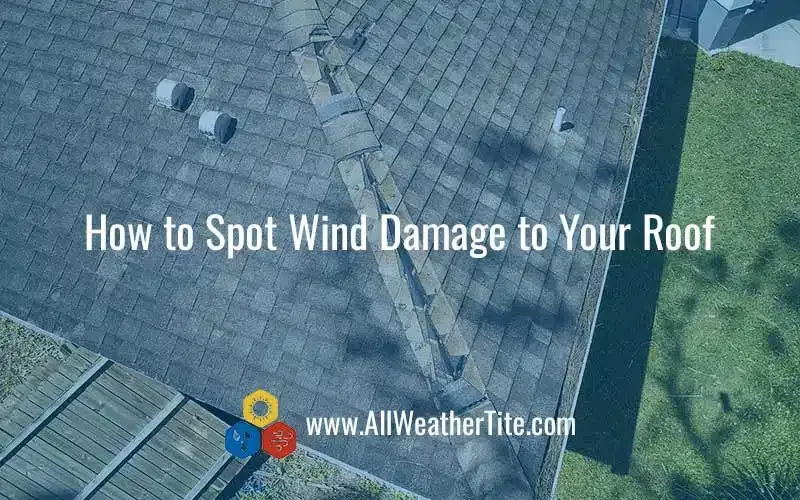
Your roof is designed to put up with everything Mother Nature brings in Southwest Florida. Year after year, it shrugs off the elements, from heat waves to hailstorms. While torrential rain and hail certainly have their impacts, perhaps nothing affects your roof quite like heavy winds. Wind damage can make your roof more susceptible to water damage, even if there are no visible signs of severe wind-related issues. When should you be concerned about the effects of wind on your home’s roof? What damages should you watch for? Most importantly, when should you call in the experts? This quick guide to wind damage will answer these questions and more. How Does Wind Damage Your Roof? Although your roof is designed to withstand all sorts of weather, windstorms can be surprisingly destructive. Most roofs can handle winds up to 90 mph, and in areas prone to hurricanes, they are built for even higher winds. But in reality, it doesn’t take hurricane winds to damage your roof. According to the National Severe Storm Laboratory, severe thunderstorms can generate winds exceeding 100 mph, about twice the 50-60 mph threshold for damaging winds. Some of the effects of extreme wind damage are more obvious than others. For example, wind damage can cause entire sections of your roof to bend, lift or even fall off. Causes of other obvious damages are heavy hail, flying debris or branches. But then there are the not so obvious signs. Wind damage can aggregate over time causing issues of increasing severity you may not notice until it’s too late. Any time wind lifts shingles away from your roof, roofing nails loosen and the sealant bond between the shingle and the roof is broken. This increases the likelihood that water will make its way into your home even if the shingle stays on the roof. Missing shingles can create weak points so that future wind storms can get underneath the remaining shingles, creating lift and risking entire sections of shingles flying away. Meanwhile, weakened corners, valleys, and flashings allow water to seep into your home. What Should You Look for? After heavy winds, perform a quick external inspection of your home’s roof. Watch for these signs of moderate to severe wind damage: Missing shingles. Look for obvious bare spots on your roof as well as shingle debris scattered about your property. Damaged shingles. Damaged shingles may be missing granulation, curled at the edges, cracked, broken or torn. Damaged or missing roof components. Components such as ridge vents and gutters may be cracked, sagging, broken or missing. Tree limbs and debris. Tree limbs, leaves, and other debris on the roof indicates winds heavy enough to lift shingles and begin causing water damage. If you suspect damage, contact a licensed roofing contractor to evaluate your roof as soon as possible. Your contractor should document wind damage with both a written description and photos. They can provide a detailed inventory of needed repairs along with a cost estimate free of charge. Also contact your insurance company to report the damage and find out what your insurance covers. It is also a good idea to look at your manufacturer warranty and contractor warranty as well. If your roof fails as a result of sloppy workmanship or poor-quality materials, these warranties may come into play. Next, perform an interior inspection. Watch for any signs of water damage, such as sagging, leaky, or discolored top-floor ceilings. In addition, check your attic for the same, as well as any wet rafters. When Should You Call? If you experience a wind storm with gusts approaching or exceeding 50 miles per hour, it is likely that there is damage to your roof severe enough to warrant repairs. As soon as you notice the above signs of damaged roofing components call a roofing expert. Failing to repair minor damage to your roof can allow wind to further damage shingles. This increases your home’s risk for moisture intrusion with each subsequent storm. Even if you don’t see any damage during your inspection, a professional roofer should be able to spot the early warning signs. The untrained eye can easily miss many of these signs. That’s why even if you haven’t noticed any signs of damage after a storm or extreme weather event, you should still schedule a roof inspection. By the time the more noticeable warning signs of wind damage appear, it’s already too late to mitigate roof damage. That’s why you need to have storm damage fixed as soon as possible. Contact a roofing expert to assess the damage to your roof and receive a quote for any repairs before beginning work. Addressing the issue now can prevent water damage, and potentially a total roof replacement in the near future. All Weather Tite can handle roofing repairs ranging from shingle replacement to complete roof replacement. Contact us to get an estimate on your roofing project.
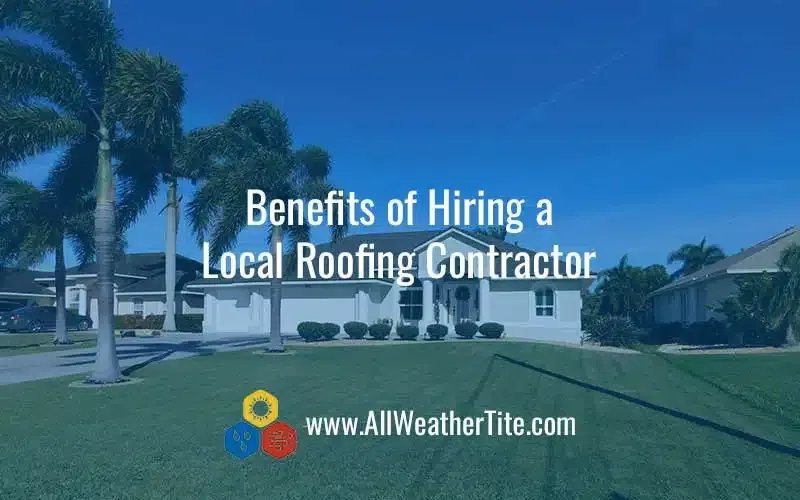
Countless roofing companies and contractors are operating throughout the United States. Some of these national companies travel to your location when there is a damaging weather situation. And a few may even be quality service providers. When you have a roofing project that requires skilled, quality workmanship, you may want to choose a locally-owned and operated roofing contractor who is well-known in your local geography. This is especially true when you have a major project. What to look for in a local roofing contractor When searching for a roofing contractor to help you with your local roof project, look for one that can provide the following benefits: Expertise A roofing contractor should have extensive knowledge and experience in the field. They should be able to offer professional and reliable services to their customers. Quality materials The contractor should use high-quality materials that are designed to last and provide maximum protection for the home or building. Competitive pricing The contractor should offer competitive pricing for their services, while still providing top-notch workmanship and customer service. Convenience A roofing contractor should be able to work around your schedule and provide flexible scheduling options. This can help minimize disruption to your home or business. Customer satisfaction The contractor should prioritize customer satisfaction. They should be willing to go above and beyond to ensure that the client is happy with the finished product. Consider the following reasons to choose a local roofer before making any commitments on your next roofing project. Benefits of choosing a local roofing contractor Easier to verify It’s vital to choose a roofer with the appropriate licenses and credentials to handle your roof work. You might ask a roofer for a quote and be shocked that it is much lower than you anticipated. But a quote that is significantly lower than the competition could be a sign that the roofer isn’t exactly qualified to handle your project. When you choose a local roofer, it will be much easier for you to get information on their expertise. A local roofer will have licenses and other professional credentials listed locally for easy access. This allows you to hire them more confidently. Lower chance of compliance issues Local roofers are going to be more familiar with the building codes and regulations in your area. Your roofer needs to be able to sign all the permits required for the work you need completed. Choosing a local roofer eliminates the risk of your roof being torn down in the future due to a compliance issue. If you choose a roofer from outside your area to finish your project, even a small compliance issue can cause further expense and potentially even legal issues between you and the noncompliant roofer. Higher level of trust Your current roof project probably won’t be the last one you will need. You probably won’t need a complete roof replacement for a long time. Smaller projects such as repairs, cleaning, soffits and vents may be needed. When you work with a local roofer, you are more likely to build a relationship with them. This can foster trust and confidence in their work. Plus working with a trustworthy local roofer is one of the best ways to ensure you have easy access to a team you can trust for future projects. Supporting a local roofer is mutually beneficial for both you and the local contractor you support. While they earn your business over the years, you have peace of mind knowing you have a trustworthy roofer to contact any time you need help with your roof. More personalized service A local contractor can offer more individualized service than you would expect from a larger roofing company that operates in a more corporate fashion. Local roofers are able to respond more quickly to emergency situations or urgent repairs because they are located nearby. Working with a local roofer also offers the opportunity to get quality referrals to other home services providers. Ultimately, choosing a local roofer to assist with your project is one of the best ways to not only support your local economy but your local community as well. Overall, working with a local roofer can provide a level of convenience, trust, and knowledge that may not be possible with a larger, out-of-town contractor. If you are in need of a quality roofing contractor, contact us for an estimate in the Port Charlotte and surrounding areas of Florida.

Most residential homes use asphalt roofing shingles. They are a popular choice because of the many styles and colors available. They are not only affordable, but also provide the protection your home needs while giving your home curb appeal. If you are planning to replace your roof anytime soon, here are the things you need to know so you can make an informed selection. Fiberglass and Organic Asphalt roofing shingles come in two types: organic and fiberglass. Organic shingles are based on waste paper saturated with asphalt to make it waterproof, with coatings of adhesive salt and ceramic granules embedded on top. Fiberglass shingles are made with a base layer of glass fiber reinforcing mat. This mat is coated with asphalt, which contains mineral fillers and makes the shingle waterproof. While organic shingles are more durable than fiberglass, they are more flammable and hence more prone to fire. They are less environmentally-friendly due to their high asphalt (oil based) content. Fiberglass shingles offer excellent fire protection. Today, fiberglass shingles are more commonly used and are slowly, but surely, replacing the organic shingles. Cost and Warranties Asphalt roofing shingles are one of the least expensive roofing materials you can select for your home. With a general lifespan of 15-18 years, asphalt shingles are the most affordable option in the short term. If you’re looking for a decent level of protection along with cost effective value, then this is the route to choose. You also want to look into the warranties provided with these shingles. A solid warranty will mean that the cost and affordability become even greater value to you. Styles and Color More affordable doesn’t necessarily mean boring. With many styles to choose from, you can give your home a varied look, whether you have a contemporary or traditional style home. There are three categories of asphalt shingles based on their characteristics and pricing. Three-tab shingles have cutouts along their lower edge, making each shingle look like three separate pieces once installed. These have been around the longest and are still the most economical and popular shingle. Architectural shingles have no cutouts but their lower portions have an additional asphalt layer, giving them the contoured, dimensional look. Luxury shingles have the appearance of authentic slate tiles and are thicker than architectural or laminated shingles. Premium asphalt shingles cost more than standard shingle types like organic asphalt, fiberglass, 3-tab and architectural shingles. Asphalt shingles are now very versatile in look, making them hard to distinguish from slate, wood shakes or tile. The higher-end shingles can give your home the look it needs to complement its style while providing the durability and protection you need from the elements. Color choices are more extensive today, giving you even more options depending on the style of your home. You can find all shades of gray, but also brown, beige, blue and green. Work with your professional roofer to help you choose the best options for your home. Ease of Installation The great thing about asphalt shingles is the relative ease of installation. Any roofing contractor with experience and proper training can install these shingles correctly. Just remember that your roof is a system, not just a layer of shingles. Be sure to research your roofing contractor to be sure they install the complete roofing system so that your home is protected. Looking to install new asphalt roofing shingles on your home? By understanding the various aspects of asphalt roofing shingles, you can decide what you want in style, color, durability, cost and ease of maintenance. For more information on roofing shingles and how to choose the right ones for your home, contact All Weather Tite Roofing in Port Charlotte, Florida.
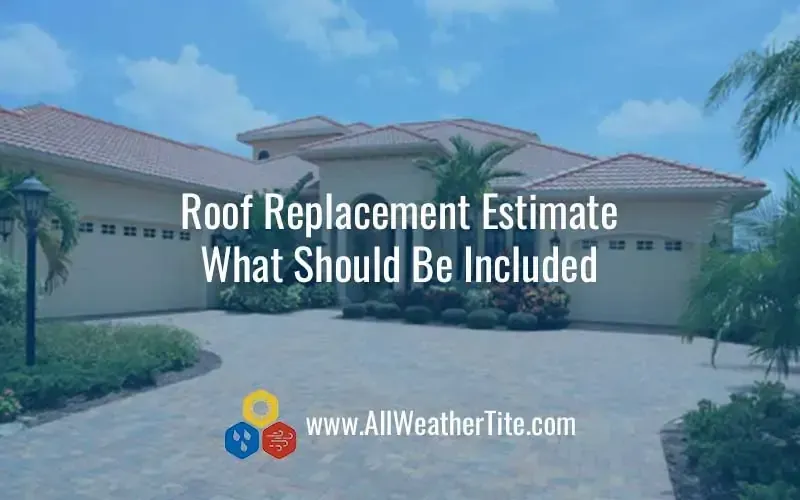
Whether you are a new homeowner, or have been living in your home for many years, replacing a roof is something that you will have to do at some point. Although this type of extensive undertaking can be a little bit scary to think about, knowing what you’re up against and doing some proper research can take a little of the unknown out of the equation. By knowing what to expect when getting a roof replacement estimate, you will know who the highest quality roofer is at the fairest price available. Gather some information Before you start soliciting for bids for your roof replacement estimate, it is important to gather some information. Start by deciding on the type of roofing material that you want to use. What type of roof do you want? This can be something as simple as choosing between metal, slate or composite shingle roofing. Or you may want to choose a particular color or style of shingle. With all of the different shingle varieties available, you can get great roof protection in a very attractive package. Choosing a high quality roofing material installed by a professional roofer is a great investment. It will help improve not only the structure of your roof, but the overall efficiency of your home. Contact some roofing contractors After you have made this decision, it is time to start calling the contractors in your area. You can start on this process by talking to your insurance company and to your friends and neighbors. Be wary of any fly-by-night roofing companies, especially right after a significant weather event. Once you have decided on who is on your list, request estimates from each. Then compare the estimates side by side. A roofing estimate should take about 30 to 60 minutes to complete. Whenever you get your roofing estimate, you will want to look for a number of items that should be present. If an estimate does not include all of these important things, then it should set off red flags and you should remove them from consideration. Roofing estimate components The following should be in a roofing estimate: Project Start Date This is the day that they will actually begin work on your roof. This is a very important detail to know, as you will need to ensure that it is soon enough to meet your needs. Estimated Completion Date This is just as important as the starting date. How fast does this particular contractor finish their work? Although the exact duration may not be as important to some as to others, you will want to choose someone who can finish in a timely fashion. Full Work Description An estimate should include a very detailed description of the work that is to be done. This will include a detailed list of: All roofing materials Underlayment type and thickness Flashing locations The size of the nails and fasteners that will be used. Sealant Type In addition to the materials above, the estimate should provide the type of sealant that will be used to seal any areas that require waterproofing, such as flashing and nail holes. Guarantees and Expectations In addition to the above, your contractor should also include a section that discusses the workmanship guarantees, material guarantees and cleanup expectations. Roofing manufacturers offer extensive warranties and roofing contractor certification programs to ensure you get a qualified installer. Insurance and Licenses The roofing contractor you hire should make their insurance and licenses visible on the estimate. This helps you determine if they are reputable. If the roofing contractor you select doesn’t carry the right insurance or have the proper licenses to be able to pull a permit, then steer clear of that company. All of these roof replacement estimate factors are very important when it comes to having a roofing contractor replace your roof. Go over the details of each document closely so that you can choose the contractor that best meets your expectation for the type of work to be done at a price that meets your budget. Once you have decided, it’s time to accept their proposal and let them get to work!
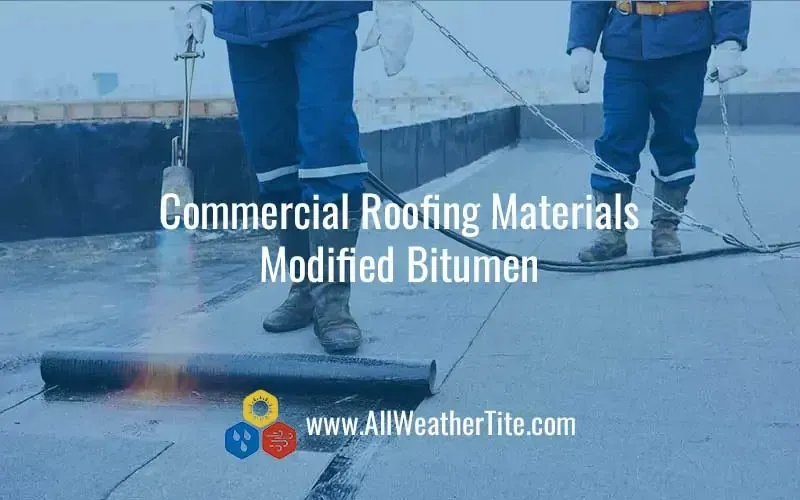
There are several types of industrial and commercial roofing materials. In this 5 part series we cover each of the following: EPDM, thermoplastic, built-up , modified bitumen, and metal . Each material has its own advantages and disadvantages and any of them can be the right choice depending on your building, climate and budget. In this installment of roofing material for commercial buildings, we look at modified bitumen. What is Modified Bitumen Roofing? Modified bitumen roofing was first developed in Europe in the 1960s and was introduced to the United States in 1972. The unique design focused on incorporating polymer chemistry into the benefits of a modern built up roof. Modified bitumen is one of the more popular commercial roofing systems in North America. It is designed for buildings with low-slope or essentially, flat roof structures. Advantages of Modified Bitumen Roofing There are several advantages to modified bitumen roofing, such as: Combines the durability of a built-up roof with the elasticity of a single-ply Eliminates the gravel surfacing Easy inspection Easy to find and repair leaks Lower maintenance cost because granule surface doesn’t require coating Weather resistant These advantages are what make modified bitumen roofing very popular in built up roofing situations. Disadvantages of Modified Bitumen Roofing The modified bitumen roofing system is extremely popular and for good reason. While there are many benefits, these roofs need proper installation, or the following can occur: Poor installation drastically reduces durability (find an expert) Torch applied installation includes danger element of fire Installation in low temperatures can cause material to be less weather resistant Although there are some negative aspects of the modified bitumen roofing system which you should be aware of, the general opinion is that these are great roofs for the right building. The Installation of Modified Bitumen Roofing Your contractor can install modified bitumen roofing in four different ways. Each method may be the correct choice under the right circumstances. Hot applied Cold applied Torch applied Self-applied There are several reasons you may choose one of the methods. The method you choose depends on: Location Roof access Style and use of facility Insulation type Climate Make sure your roofer is an expert in modified bitumen and is qualified to make the correct choice. When you are deciding what material to use for your commercial building, you should consult with an experienced, licensed roofing contractor. All Weather Tite of Port Charlotte, Florida, is a GAF Master Elite® certified roofing contractor. This guarantees that we are fully licensed, fully insured, have a proven reputation for quality, and are committed to ongoing professional training. Check out the commercial roofing section of our website. You can request a free estimate and we will be happy to explain your options regarding recoating your roof. Our expert services cover all aspects of roofing from new roofs to minor repairs.
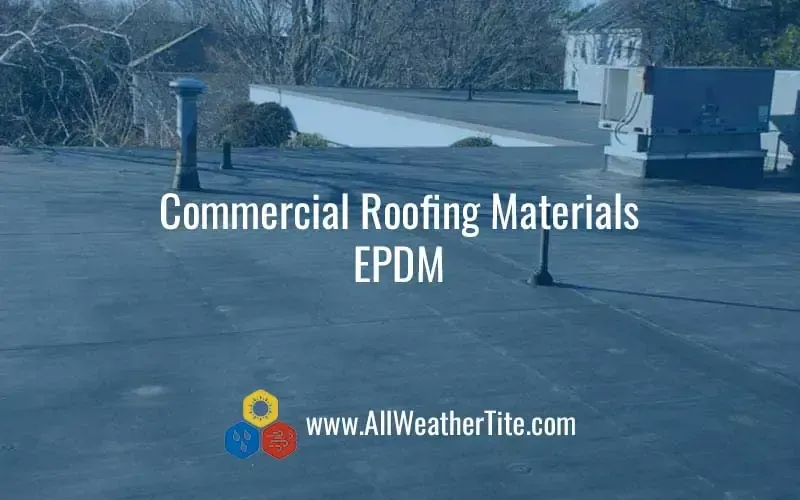
There are several types of industrial and commercial roofing materials. In this 5 part series we cover each of the following: EPDM, thermoplastic, built-up , modified bitumen, and metal. Each material has its own advantages and disadvantages and any of them can be the right choice depending on your building, climate, and budget. In this installment, we look a popular material for commercial buildings: EPDM. What is EPDM? The EPDM (ethylene propylene diene monomer) roofing system is a synthetic rubber based material used very successfully on large commercial buildings. While not a new invention, EPDM is still relatively new to the roofing industry, yet has become one of the top choices for low slope roofing over the last 40 or so years. It is made of rubber similar to that used as seals in cars (around doors or the trunk) or the seals around the doors of walk-in freezers or fridges. EPDM Background The EPDM systems have remained mostly unchanged for the last several years though a few improvements to adhesives and the reflective qualities of the material have enhanced performance. Many of the EPDM systems you will see today have been around since the 70s and though the originals don’t have a few minor updates featured by current versions, they have proven to be long lasting and durable. Since there are EPDM roofs still in use which are 40 years old, a 30 year guarantee is often available upon installation. Advantages of EPDM There are many great features about EPDM roofing systems which make them attractive to building managers. Very durable and long lasting Low cost life-cycle Rapid installation Environmentally friendly Flexible and versatile Material is nearly 100% recyclable Low fire danger Nearly waterproof when installed in one piece This is a potent lineup of advantages which has made EPDM’s wildly popular as a low slope commercial roofing option. Disadvantages of EPDM As with all types of roofing, there are also drawbacks. HVAC units, piping, and other fixtures can cause the possibility of a leak. The roof may need to be resealed. Leaks, though rare, can be hard to find if they do occur Unqualified roofers incorrectly installing EPMD To the last point, this is a common occurrence. Double check your roofing company to verify that they have experience in rubber roofs. This is extremely important as this is not a simple shingle residential roof. EPDM Ballasted System The most frequently used EPDM is the ballasted system (about 35% of modern commercial EPMD installations). This system starts with approved roofing deck at the bottom, upon which sufficient insulation is placed. The contractor lays the EPDM panel on top of the insulation. Smooth stone or concrete pavers hold the panel in place. This creates a low cost, durable, water tight, heat reflecting, and fire proof roof. EPDM roofs are often a good base for solar panels. When you are deciding what material to use for your commercial building, you should consult with an experienced, licensed roofing contractor. All Weather Tite of Port Charlotte, Florida, is a GAF Master Elite® certified roofing contractor. This guarantees that we are fully licensed, fully insured, have a proven reputation for quality, and are committed to ongoing professional training. Check out the commercial roofing section of our website. You can request a free estimate and we will be happy to explain your options regarding recoating your roof. Our expert services cover all aspects of roofing from new roofs to minor repairs.
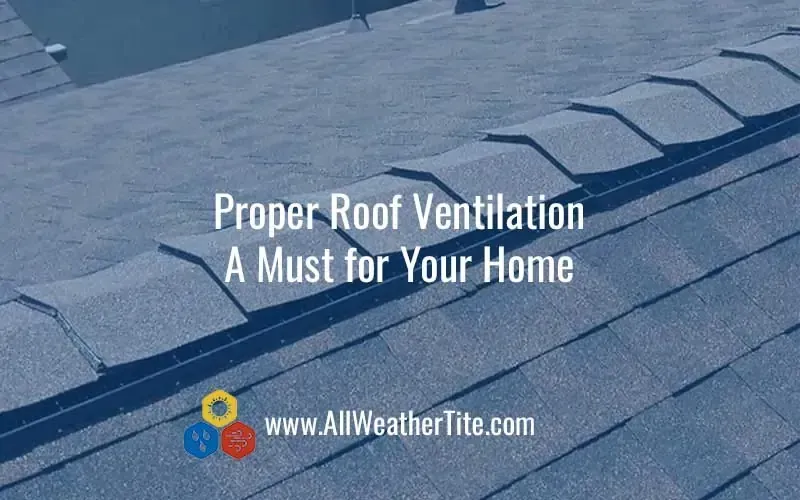
Your roof is one of the most often taken for granted, yet extremely important elements of your home. It is typically out of our reach and requires infrequent maintenance so many homeowners are unaware of important areas that affect its longevity. Making sure that there is proper ventilation for your roof is one of the most important things that you can do to prolong the life of both your roof and the structure that it protects. What is thermal comfort? “Thermal Comfort” is a buzzword of modern home building and renovation. It is aimed at making the environment as perfect as possible when it comes to the temperature of the home. This is done in two major ways: Isolating the home against the outside temperature with insulation and airtight double/triple paned windows and doors Regulating the internal temperature through heating and air conditioning, ideally with an HVAC. All this technology can lead to complications that can damage your home and make life miserable for you and your family. The Woes of an Air Tight Home With the airtight system of the modern home, things are entering the environment, but not leaving. This leads to a closed system and a home that cannot breathe. The buildup of evaporated water from activities such as cooking, cleaning, and breathing is the largest concern for such a home. This is water that cannot leave your closed system. If your home is suffering from humidity, condensation, allergies, or mold growth, you might have a home that needs ventilation. An estimated 9 out of 10 homes don’t have a properly balanced attic ventilation system in place. As a result, the average roof lasts only 10 to 12 years, even though most roofing shingles are made to last 25 years or more. In fact, the number-one reason for premature roof failure is inadequate ventilation. What most homeowners don’t realize is that without proper roof ventilation, most manufacturers’ shingle warranties are void. That means those same nine out of 10 homes may never have even had valid warranty protection on their roofs. Ventilation vs. Air Leakage The unregulated and unintentional escape of air is air leakage. When air, especially hot air, is leaking out, your heating or cooling systems have to work that much harder. And that costs you money. Ventilation comes in two forms: Direct ventilation, such as opening a window Indirect ventilation, designed to allow the flow of air and humidity and control temperature loss or gain. The largest form of indirect ventilation should be your roof. Proper roof ventilation helps regulate the temperature inside your attic by pulling fresh air into the attic and pushing out heat and moisture. This in turn reduces the temperature difference between the air outside and in the attic, preventing damaging heat and moisture build-up. Why your roof needs appropriate ventilation Regulate Heat Build-Up One of the main reasons your roof needs proper ventilation is to make regulate the heat inside your attic. During summer, the temperature is going to be very hot regardless of the amount of ventilation that you have. If you lack the proper ventilation, however, the temperature could reach upwards of 160 degrees Fahrenheit. This heat is detrimental in a variety of ways. The wood in your attic and the asphalt in your roof can age prematurely as a result of heat damage. Extreme heat in your attic can also make your air conditioning system work harder by heating the air ducts running through the area. If you have leaky ducts, the hot air can also leak directly back into your home. Reduce Moisture Build-Up When the temperature in your attic is poorly regulated, one of the main side effects is an increase in humidity. This moisture is much more dangerous than the heat itself. Humidity will condense on the interior and within the roof itself, leading to water damage and rot that might not be covered under your last roofing guarantee. If enough moisture builds, it can even seep into your walls and ceiling, resulting in extensive hidden water damage, mold growth and a very unpleasant musty odor. Since the roof and attic are the main area for humidity to collect in a climate controlled home, it’s important to have airflow in the roof and a ventilation system to spread it around the home. Avoid Excessive Ventilation Although it may be tempting to install as many fans and vents as possible, there are also some dangers to over ventilating. Electric attic fans can pull too much air out of your attic. This can cause combustion gases from your water heater or furnace to be forced back into your home. Because of this, this type of ventilation is no longer recommended. Work with a professional to make sure that your roof has the perfect amount of ventilation. As you can see, proper ventilation is a big factor in maintaining the longevity of your roof. Proper ventilation reduces chances of ice damming, lowers heating and cooling costs and keeps mold and mildew from forming. Primary Source of Ventilation: The Roof There are two major points of ventilation: below the eaves and along the top-most point or ridge of the roof. Eaves Permeable ventilator strips are installed beneath the eave. Permeable strips allow humidity to through. You can also ventilate using tile vents set at regular intervals. One ventilation set on either side of the attic can allow air to enter from one side and leave through the other, taking humidity and other environmental buildup with it. However, if you’ve got a crowded or cramped attic, it’s time to add a ridge vent. Ridge Using a continuous ventilation strip, or ridge or tile vents, you can install a similar ventilation on the ridge of the attic and roof. The ridge is the topmost joint of the triangle. This ventilation allows hot, humid-laden air to leave through the roof. That draws in fresh air down at the eaves which allows for a continues flow of air. Your roof is your home’s protector Your roof plays an important role in the overall safety and life of your home. You should educate yourself about its care and maintenance. If you have a relatively new roof installed by a credible roofing company, then you most likely have proper ventilation. If your roof is older, or you are unsure who did the installation, it may be worth your while to have it looked at by a professional. One way to test whether you have enough ventilation is to take the temperature of your attic on a hot day. If there is more than a 15-20 degree temperature difference over the outside temperature, then talk with a professional roofer about improving your roof’s ventilation. Contact All Weather Tite for a free roof inspection and estimate. Our experts can provide a free estimate, explain proper roof ventilation and get to the bottom of any current ventilation issues with your roof.
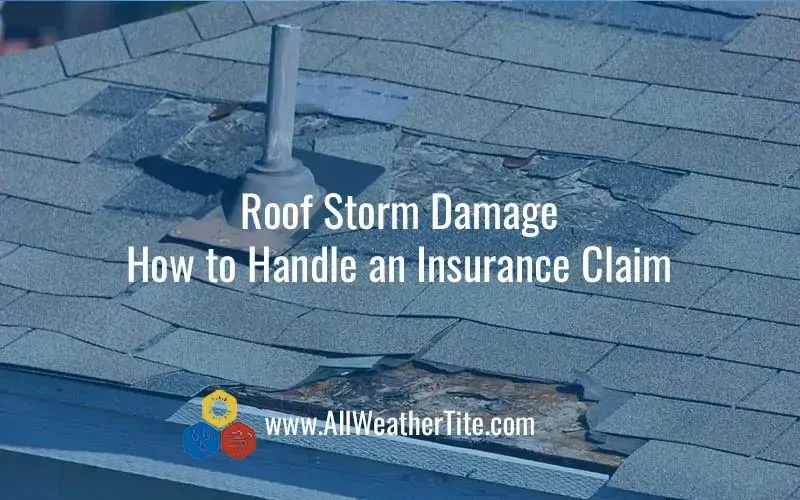
The effects of Mother Nature can be very damaging to homes especially along the coastline. If your home has suffered roof storm damage, it is important that you have the damage repaired quickly. Your roof provides your home with its first line of protection from the elements. Any damage can result in increased damage to your home. Most insurance policies limit the amount of time you have to make a claim after an event such as a storm. It can really pay off to act as quickly as possible. If you wait too long, you may not even be able to make a claim. Plus, you could find yourself dealing with dripping water, mold growing in the walls, ceiling and attic and even roof cave-ins. Roof storm damage due to harsh weather is something that troubles a homeowner. Many times, you aren’t sure of how to handle the insurance claim. The best thing you can do is to hire a high quality roofing contractor that has your interests in mind. Be wary of storm chaser roofing companies that appear any time there is a large storm or natural disaster. This will ensure that you get the highest quality service, and results that are in your best interest. In addition, never meet with the insurance adjuster alone. Hire an experienced roofing contractor who knows the codes and laws around storm damage. They can help the adjuster understand what roof storm damage has occurred and what it will take to fix it. In our experience, some homeowners have hurt their chances of getting paid on a claim because they didn’t know the nuances of roof repair. How to make an insurance claim after roof storm damage Naturally, the claims process will vary from carrier to carrier. However, your insurance company may try to deny your claim in order to maintain as much profitability as possible. Your best defense whenever this happens is persistence and a thorough understanding of your insurance policy. Here are a few tips on what to do to prepare to make your claim. Start by assessing all of the damage done by the storm. Take careful notes, including the date of the incident and any damage that you can see. You can also take pictures of any damage. Meet with your local roofing contractor to begin obtaining estimates. Ask them to help you deal with the insurance adjuster when they come out to perform a full roof inspection. We highly recommend that you have a roofing contractor present during the inspection. You want to be sure that the adjuster sees everything that needs to be repaired or replaced. Don’t take no for an answer. If your home has been damaged by a storm in any way, it can lead to decreased value and future damage if not repaired quickly. Insist on meeting with another adjuster. Once your claim has been approved, the contractor of your choice can begin repairing the damage. Although the entire process can be intimidating and the number of steps involved makes it seem rather lengthy and tedious, filing an insurance claim is a fairly easy process. With a little due diligence, proper research, and a high quality roofing contractor, you can have both the claims process and the repairs completed in no time. Additional tips Here are a few additional tips to help you along the way: Always hire a high quality roofing contractor that has experience dealing with insurance companies. Don’t opt for the cheapest one that you can find. Even though most policies give you up to two years to file a claim, know your policy and don’t wait! The sooner you file the claim, the faster you can get the damage repaired. Understand your policy as thoroughly as possible. Avoid fly-by-night contractors. Roof storm damage claims should not increase your rates. Often roof storm damage is not visible to the naked eye. Partnering with a reputable roofing contractor who understands the issues is a benefit. If you do find storm damage, let your roofing contractor guide you through the insurance claim process. They can ensure that the scope of work required is correct and documented. Then you will be able to get the damage fixed the right way the first time.
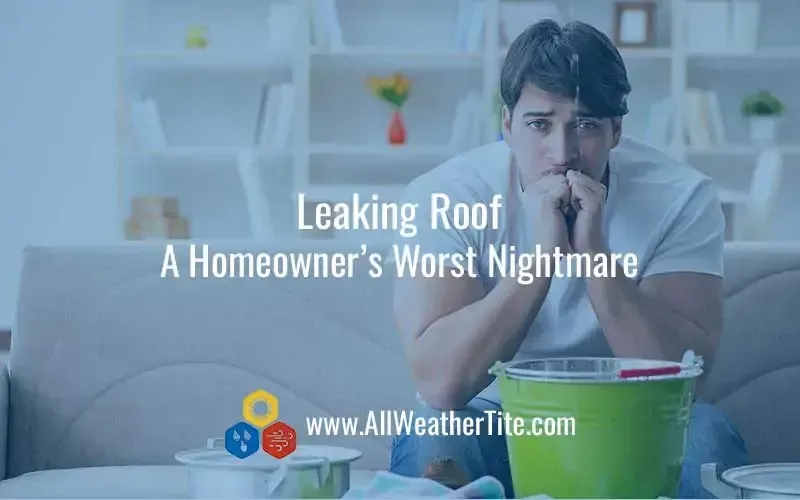
The sight of a water leak from above makes most homeowners shudder. When water starts pouring down your walls or through your ceilings, you may feel helpless. By the time you see the leak, a considerable amount of damage may have already occurred. This will require a roof repair and possibly mold and water damage mitigation. However, homeowners can take proactive steps to mitigate the damage from a leaking roof. Once you have discovered a leak or a water stain as evidence that something is leaking, make your roof repair a high priority. The longer a leak remains without being properly repaired, the more challenges you will face in remedying the issue. Water damage can affect the structure of a roof as well as the attic and ceilings below the leak. Ongoing leaks can result in many nasty problems like odors, mildew and mold that can be hazardous to those living in the house. Tips to Address a Leaking Roof Before you find yourself in a crisis situation, here are a few tips to address a leaking roof and make sure your home receives a quality roof repair: 1. Act fast if the leak is storm damage If a new leak starts from some kind of damage to the roof during a storm, immediately call a reputable roofer that not only can repair the roof but also help you through the insurance claim process from start to finish. 2. Trace the leak to its source If possible, trace the problem to its source. You can help the roofing contractor solve the problem more quickly if you can find the cause of your leaking roof. 3. Find a reputable roofing company A challenge for most homeowners is to find a quality roofing company that will do the job right. Check to make sure that the one you decide to call has the proper credentials, licenses and insurance. Look them up online; see that they are known and recommended in the community by other homeowners. Check out their reviews on review sites like Yelp or Google+ Local. 4. Get a professional quote Before you hire the roofer, make sure they come to your home, assess the situation and provide a professional quote. Since water can travel a distance from where the leak originates, you need to find the source of the leak. This is critical in order to properly repair and prevent more damage. A qualified roofer will find the actual source of the leak before giving a quote. They want to be sure that their estimate of the required work is accurate. Only once the problem has been identified can the repairs begin. The work required to fix a leaking roof usually involves more than just replacing a couple of shingles. For example, the roofer may suggest removing the shingles from a much larger section of roof based on the roof’s shape, angles and corners. Usually this lessens the chance of water seeping under a small patch of newly placed shingles and creating new leaks. If the contractor has come highly recommended, trust their judgement and let them fix the problem the way they suggest. Taking shortcuts will only result in more issues later on. 5. Get your roof inspected regularly to avoid leaks in the future Once you have the roof repaired, prevent future leaks by having your roof inspected regularly by an experienced roofer. By making roof inspection a regular part of your home maintenance, you can avoid costly future roof repair. A roofing contractor will find trouble spots before they become actual problems. Whatever issues the roofer finds during the inspection, have them provide an estimate for fixing them immediately. This will save you from having to deal with a more serious problem later. Even though a roof replacement should last you many years, you should partner with a reputable roofer whom you can periodically call to inspect your roof and keep it in good shape.
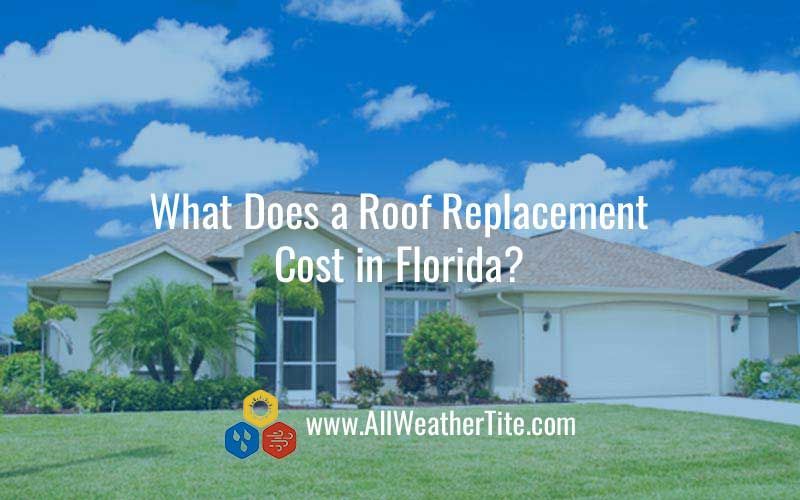
As a homeowner, the number of times we need to replace our roofing system is minimal. In fact, with today’s lifetime warranties, many homeowners may only need to go through this project once. But when your home is in need of a roof replacement, what is a fair estimate for a roof replacement cost in Port Charlotte, Florida? Let us share what it should cost you to replace your roof. Roof Replacement Cost – What to Consider Roofing contractors consider several factors to determine the price of a new roof. These factors include: Roof type (flat, sloped, high or low pitch) Size of the roof Layers of shingles already on the roof Materials selected: metal roofing, shingles, tile roofing, asphalt roofs Hidden roofing problems Roof features such as chimneys and sky lights Therefore a simple roof with a light slope, few angles and no features like skylights or jutting windows will cost you the least amount while a complex roof with a steep slope, multiple chimneys, skylights and varying angles will cost you more. Roofing Cost Calculation Let’s take a look at how a professional roofing contractor would provide you a quote for your home. Roofing professionals typically quote materials in squares, which is 100 square feet or a 10-by-10-foot area. For a new roof using GAF asphalt shingles, plus quality workmanship and lifetime warranty, you should expect a price of about $650 a square.
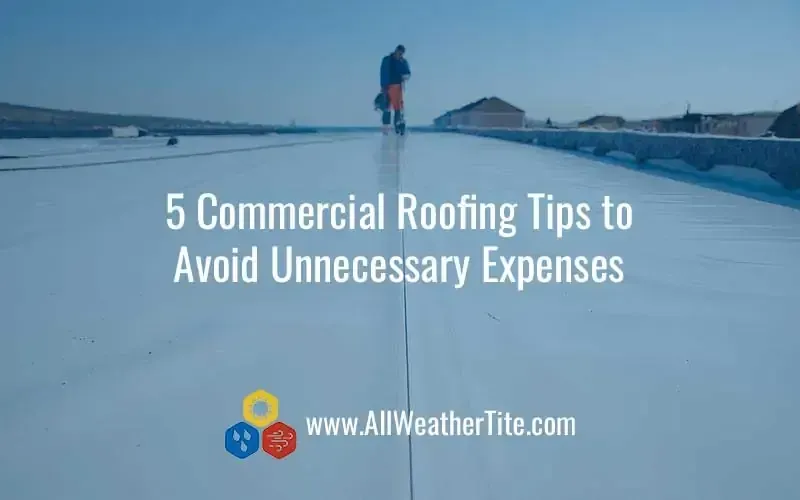
You own a commercial building. And one thing you know for sure: if your roof leaks, you will hear it from your tenants. Installing a quality commercial roofing system and performing regular maintenance, is an important priority. With a the wide array of commercial roofing products, you can choose a roof that fits the aesthetics of the building while still performing as a protective shield. All roofing material on the market has pros and cons. Various materials work best for one industry over another. Consult with an expert commercial roofer because there are roofing materials that are not the most ideal or practical for your industry or building style. These materials can limit the lifespan of the roof. If you’re planning to install a new roof or need to make changes to your existing roof, the following commercial roofing tips will benefit you and help you avoid any extra or unnecessary expenses. Consider the right type of roofing Commercial roofs are commonly made of steel, copper, and metal. Tiles made from clay, rubber or concrete can also be used. Consult your roofing expert on the best products for your building. They will help you choose a roofing material that offers high performance and durability even if it means spending a bit more on the materials. Hire the right roofer Whether you need a new roof or only minor repairs, never try to do it yourself. Also never allow an inexperienced person to fix your roof. Sometimes small roofing issues can become big headaches because the contractor had no experience dealing with the underlying cause. Always choose a licensed and insured roofing contractor who will stand behind their workmanship to perform all repair and maintenance work. Care for your roof While the materials used in a commercial roofing system offer durability, a commercial roof should still be maintained and inspected regularly. It is not enough to only choose the right, high quality roofing materials. Perform routine inspections and be sure to note any signs of damage. Perform scheduled maintenance for your roof to eliminate surprises and catch small issues before they become major challenges. Don’t wait until you notice a leak inside the building. Ignoring what you see will end up costing you. Hire a roofer for their professional opinion if you are unsure of whether there are issues. Listen to the experts Listen to your contractor’s advice regarding what is best for your commercial roof. They are trained on how to identify potential problems before they become major. If your contractor tells you that the most cost effective solution is to replace your old roof with a new one, listen to the expert. As with many things, trying to salvage an old roof may be a total waste of time and money, causing you to continuously pay for repairs. Do whatever it takes Do your best in keeping your commercial roof in top notch condition. If you need to hire a roofing contractor, do your homework. Work with one that can guide you on selecting the correct materials. Remember what is at stake here: your roof is important so do your best to ensure you are able to handle any issues that can arise. Installing a commercial roof is one of the biggest investments you will make in your business. Implementing these commercial roofing tips will ensure that you get the most out of your roofing system. Investing in the right products, a quality roofing contractor and regular maintenance can prevent unnecessary expenses and help extend the lifespan of your roofing system.
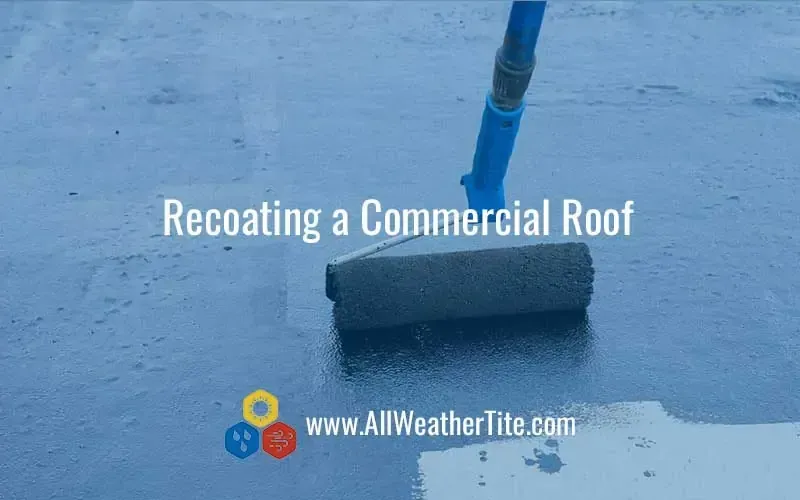
There are times when a commercial roof will need to be recoated. While this may be a nuisance and an unwanted expense, in the long run recoating your roof can save huge amounts of money. When a coating is applied properly, it tends to lower cooling costs, while extending the expected roof life. It should also reduce the amount of repairs needed. Your commercial roof is a huge investment, it makes sense to protect it. Types of Coatings First the type of recoating used on your roof will depend on what type of roof you have. There are several types of coatings which are designed to work best under specific adhesive and weather circumstance. When can specify asphaltic and tar-based coatings for use with coal-tar-pitch built-up roof systems. For single-ply systems it is common to use non-asphaltic coatings. Remember that roofs are made differently, are used differently, and have different needs. It is important to consult with your roofing contractor to make sure your coating is most effective for your specific roofing needs. Why Should You Recoat Your Roof? There are several good reasons to recoat your roof. Reduces cooling costs Extends roof life Fewer repairs Protects against UV rays Protects against leaks Periodic recoating is less expensive than new installations A good roof coating will make a big difference in your roofs life and the overall health of your building. Recoating is often a more popular choice than a full repair. This is not only because it is less expensive but also because there is less dust and debris, no downtime while the building is exposed to the elements, among other things. How Often Should You Recoat Coatings will last for several years. Most warranties recommend that you recoat every 10 years and often you will have too if you want to keep the warranty intact. In reality, coatings sometimes last longer than that, however, you will lose your warranty if its stipulations are not followed precisely. Such things as environmental and climate will affect the coatings length of life. Make sure the roof is being properly maintained, including small repairs. If you don’t do this, a re-coating will eventually not be good enough. Recoating Your Roof Can Save You Tax Money Another advantage is that recoating or restoring a roofing system is that it can save the business owner money on taxes. A roof restoration is classified as maintenance which usually will be expensed in the accounting period in which it is incurred. However, installing a new roof system is classified as a capitol asset which must be amortized over several years. Of course, if your roof has serious issues, it’s not wise to opt for the cheaper recoating just to save a few bucks. Make sure your roof is sound and performing well. For more tips for your commercial and residential recoating, talk to our expert team. You can request a free estimate and we will be happy to explain your options regarding recoating your roof. Our expert services cover all aspects of roofing from minor repairs and ventilation to full replacement of both commercial and residential buildings.
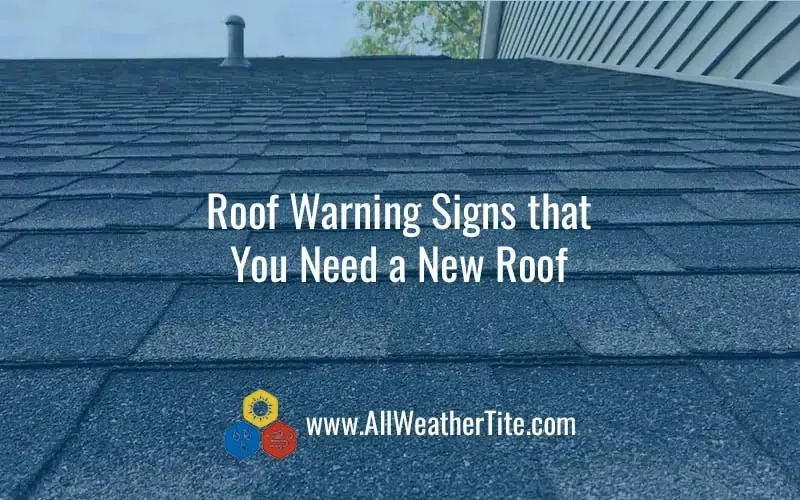
Your roof can be considered the most important part of your house. It is there for all seasons, to keep you warm and dry in the winter, and cool in the summer. A bad roof poses a very serious threat to your belongings, not to mention your loved ones. And many people do not realize that they need a new roof until water is leaking into their house. Check for these roof warning signs that indicate you may need a new roof. How Old is your Roof? Do you know how old your roof is? Before looking for any roof warning signs, you should find out the age of your roof. Most roofs last between 20 to 25 years, depending on the type of material. If you are a new homeowner, you should find out if the old roof was removed before a new layer of shingles was installed. If you have a roof installed over other layers that are over 20 years old, then you should get a new roof. Changes in Shingles If the shingles on your roof look unusual to you, get an experienced roofer to checked them out. The condition of shingles is a good way to tell the age of a roof. A roof that is past its prime will often have shingles that are curling or buckling from sunlight or ventilation problems in your attic. Check the Gutters Remember to check your gutters regularly as well. When you are cleaning your gutters, keep an eye out for granules of shingles. Pieces of shingles wear away due to weather and lose granules is a sign that a roof is past its prime. Spongy Texture If there are areas of your roof that feel spongy or soft while you are walking on it, it is time to call the professionals. A spongy feeling means that the decking that lays under the roof has suffered damage from moisture and has become weak or rotted. Check the inside of your attic for signs of moisture and for daylight creeping through the roof boards. Roof Valleys If you noticed dips in your roof, accompanied by missing or damaged shingles, it is time for a new roof. Water can collect in the valleys and can lead to leakage inside of your home. It is especially important to check valleys of a roof before and after a serious storm. Lack of Shingles in the Valley The valley of a roof is where two slopes meet. If you see that shingles are missing in the area around the valley, this is a definite sign that you need a new roof. The valley is the most important part of the roof because rain and snow travel down the valley into the gutter. Missing shingles in this area are a sign that you could be susceptible to leaks. Damage Around the Chimney Damage to your chimney flashing can cost money if you ignore the problem. Chimney flashing prevents water from entering your home at the point in which the chimney and roof of the home meet. Older homes often have flashing that is made from cement or tar. If this is the case, there may be moisture in the insulation. This would ultimately mean that you need a new roof. You should update the flashing with a new water-tight metal flashing system that is more durable and will last longer. Daylight and Moisture Many people do not check their attic frequently. After going through all of these warning signs, if you think that your roof might be nearing its end, checking your attic could be the last push you need. When in your attic, if you cannot see sun shining through the roof boards, still check for moisture in the insulation that could be hiding. Excessive moisture is a sign that your roof may be deteriorating. Many homeowners don’t think about their roof until there are obvious signs of damage, such as a leaks or loose shingles on their lawn. Most older roofs have a life expectancy of 20-25 years. If the age of your roof is 20 years or more, you should plan to install a new roof soon.
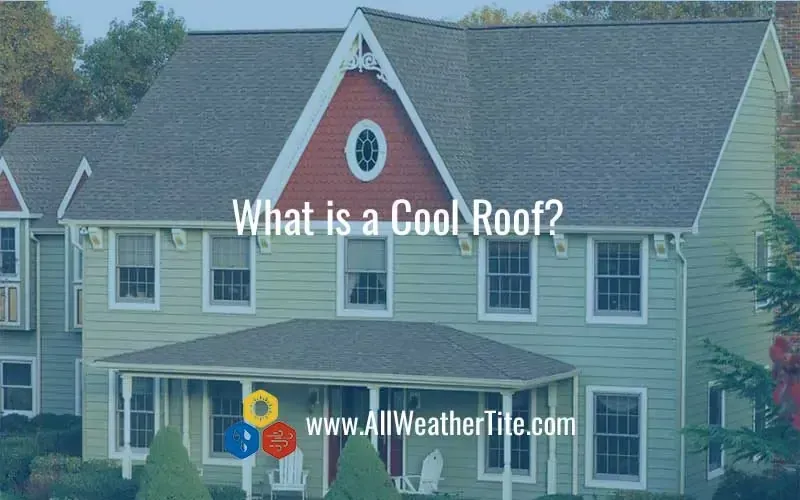
Among the many worries of a building owner or manager, staying cool in the summer and cutting costs are two things which always present themselves. Unfortunately, they seem to be in complete contradiction of each other. The sun beating down on your roof can cause its temperature to rise. According to the Department of Energy, on a sunny day the temperature of a traditional black roof can be 50°F warmer than the air temperature. When dealing with this warm climate, it would be beneficial to know how to cool your roof in the summer. However, with the growing popularity and availability of “cool roofs,” this might not be the case anymore. What are Cool Roofs? Cool roofs have been designed to reflect more light and absorb less heat than traditional roofs. They have a high emissivity, which means that they emit infrared energy. They can be made of a sheet covering, highly reflective paint, or highly reflective tiles or shingles. Benefits of Cool Roofs There are many benefits to installing a cool roof on your home or building. Lowers utility use and cost. A cool roof reduces temperatures internally and externally so homeowners will have to rely less on their air conditioning system. Homeowners can spend less on their energy bills without sacrificing comfort. Provides a longer life span and fewer maintenance costs. High temperatures cause shingles to expand and contract, causing cracks in their surface. A cool roof can help prevent this damage, extending the roof’s life. Reduces the heat island effect. When there are many buildings in a small urban or suburban area, air temperature can feel higher than it is. If buildings in tight areas replace their roofs with cool roofs, then it can reduce the air temperature around them. Also in these areas, these roofs can lower peak electricity demand which will help prevent power outages. Reduces air pollution. Cool roofs reduce cooling energy use in buildings, which reduces power plant emissions such as carbon dioxide and mercury. Costs of Cool Roofing Costs will differ depending on many variables like location, local laws, and climate. However, the Environmental Protection Agency estimates the increased cost for cool roofs is between 0 and 10 cents per square foot. This slight increase is offset by the savings. According to epa.gov:
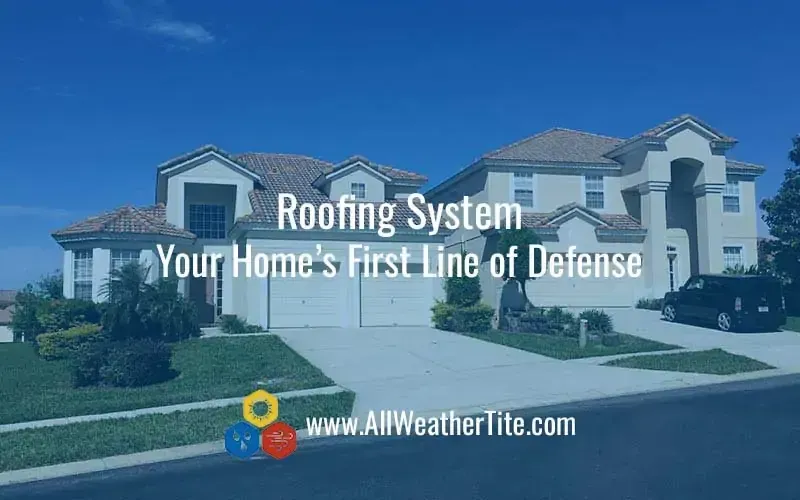
In football, the offensive line protects your quarterback. In soccer and hockey, your goalie is the one protecting the goal. When it comes to your home, the roofing system is your first line of defense that protects you from the elements. With the approaching hurricane season, it’s best to know how your roof is doing so that you can have peace of mind and not worry about what might happen to your roof depending on our fickle weather. Understand the basics on how to care for your roof to increase your defenses. Inspect Your roof may look good from afar but is it? Take some time to look for cracks in your shingles, buckling or curling, loose shingles and shingles with worn grains. Look for trees that overhang your roof as branches can fall due to storms. Often times rodents get to the roof from the branches, potentially causing damage. Gutters are a good indicator because if anything is blooming in them or water leakage is happening it’s a good sign of something wrong. If you can get into your attic, look for water spots and stains. If you see some, contact a professional to take a look and assess if there is serious damage. Repair the Existing Roof If the roof is damaged, consider your options. Not every roof has to be replaced and a qualified roofing contractor can advise you on what is best for your situation. Minor damage can be repaired if the underlying roofing system is still intact and you haven’t had any water damage inside of your home. Replace the Entire Roofing System If your roof has extensive damage and is over 15 years old, you need a roof replacement. Sometimes, home improvement projects can be a “do it yourself” situation, saving you money in the short term. However, replacing your entire roofing system is not something you should consider doing yourself. Hiring an experienced roofing contractor that can: Get you the best materials for your roof Ensure there is proper ventilation Install the flashing properly Get you the maximum warranty offered Is more than worth any cost savings you might get doing it yourself. Improve Understand what improvements can be done to make sure your roof lasts longer. Are your gutters clogged? Gutters that have not been cleaned can cause the water to build up during a heavy rain and may cause leaks. Consider installing low-maintenance gutters that keep the leaves out and protects your roofing system. Is your roof properly ventilated? Lack of ventilation can cause many problems with your roofing system, including dry rot, shingle deterioration and mold and mildew growth. Did you use a quality roofing system with a solid warranty? Choosing the right roofing contractor to install or repair your roof should also include ensuring they use GAF Roofing Systems because these systems come with the best warranty in the industry. Always remember the quality of a roof is important because it protects your home from the elements. The roofing system also protects the structural integrity of your home as well. But regardless of what the roof is designed to do, you want it to be attractive with high-quality materials and proper residential roofing installation. A roof is unarguably your home’s most important structural aspect. This is why it is so important to pay attention to the style and quality of the roofing system you use at home. Know what you’re dealing with each season and figure out the best approach to keep your roof lasting longer. What other alternatives can help increase the longevity of your roof?
